UFO 50: My 14 favorite games within my favorite game of 2024
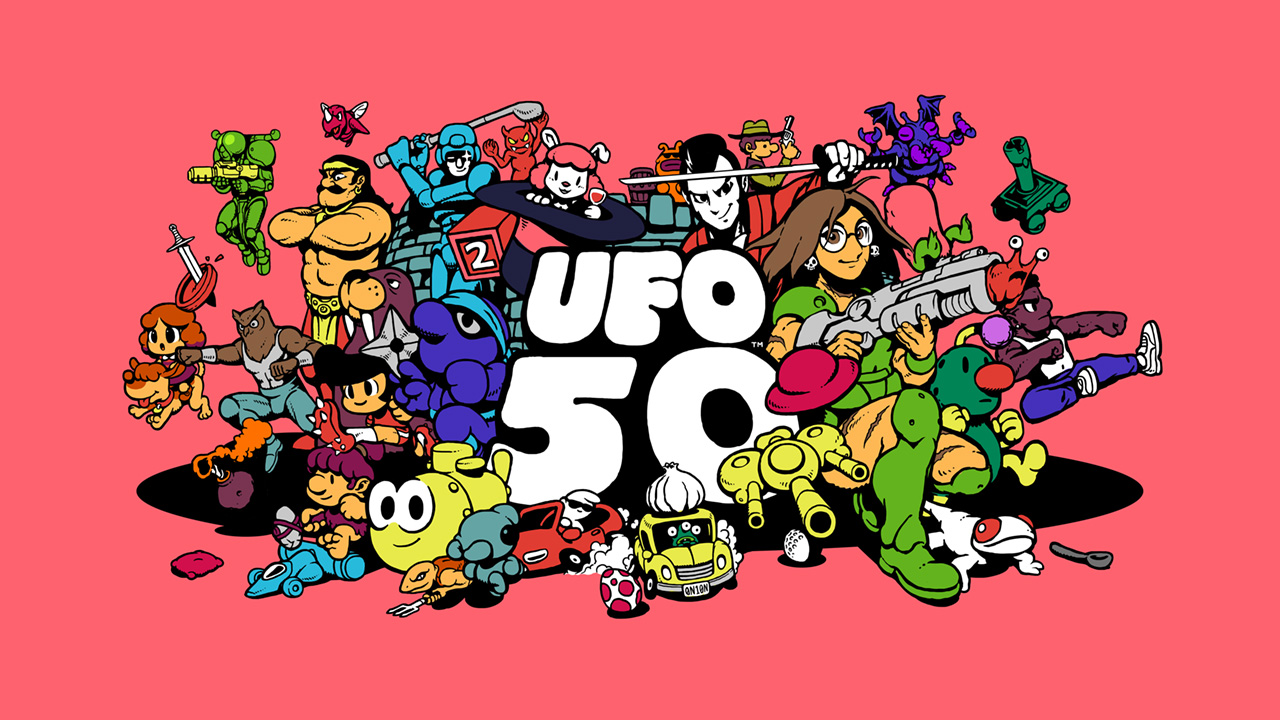
Fifty of my favorite games of 2024 just got ported to Switch all at once. What were the odds?
If you're out of the loop, let me get you up to speed first. UFO 50 is a collection of 50 new 8-bit games, developed over the span of eight years by a small team led by Spelunky creator Derek Yu and his lifelong friend and collaborator Jon Perry. (I also have to mention that Downwell creator Ojiro Fumoto worked on this, because Downwell is awesome.) As they're quick to tell you, these aren't minigames, either. By '80s standards, they're all complete games. Some are short but highly replayable games evoking the arcade era, but others are big adventures that take hours to complete. The obvious comparison to make is "Action 52, but good," or perhaps an amped up version of Retro Game Challenge, or even just a pirate multi-cart with all new games, but it's so much more than that.
Within the game, UFO 50 is framed as a collection of every title released between 1982 and 1989 by the fictional company UFO Soft for their equally fictional LX series of consoles. There are little history blurbs and in-game credits that tell you about the fictional devs, helping you piece together a narrative about the rise and fall of UFO Soft and the creative aspirations of certain employees. People will probably be theorizing about the story and what things in the games themselves may or may not represent for years. Meanwhile the real life dev team, credited as the "UFO 50 Recovery Team" in the demoscene-ass opening credits, are said to have found the collection in an old storage unit and ported it to modern hardware as an act of preservation. To match this conceit, each game was made under the same technical restrictions, using a two-button control scheme and the same 32-color palette and soundchip. Later in the system's chronological library the games become much more sophisticated, thanks to a combination of hardware improvements and the devs honing their craft. They even depict the LX systems as all-in-one units including non-standard monitors, to explain why all these games from the '80s are in 16:9 widescreen. For a certain type of classic gaming nerd who's always loved concept consoles and mockups of nonexistent NES games (e.g.: me), this conceptual layer is catnip.
And the games themselves are much more than a series of nostalgic retro throwbacks slavishly mimicking the biggest hits of the NES. While a few are fairly traditional entries in their respective genres, the devs at UFO Soft were supposed to be underappreciated visionaries ahead of their time, so the games here tend to be weird and inventive, an experimental blend of classic and modern genres with all sorts of fresh ideas. A strategy game where you and your opponent take turns flinging your disc-shaped units around the field like pucks on an air hockey table, dealing damage upon collision. An eerie dungeon crawling RPG about deep sea diving lizard people. A frantic auto battler where you scramble to arrange your troops into formation on the grid as they spawn in and march off towards the enemy. A platform fighter where all eight characters have completely different movement mechanics. An alien gambling simulator where you bet on the outcome of slapstick races. An open world golf adventure where the protagonist is the golf ball itself, and your HP is the number of strokes you can take. The list goes on and on!
These games tend to skew "Nintendo hard," without any emulator save states to help you, but they also make some modern concessions when necessary. Many have unlimited lives, autosaves are standard for any game with saving, the RPGs show enemies on the map instead of having true random encounters, and a few of the puzzle games give you the option to undo your actions. The overall level of challenge feels tough but fair. It's really fascinating how they threaded the needle here between modern ideas and the reality of gaming in the '80s.
Really, all of the games here are worth examining in-depth, but then we'd be here all day. So instead, I'm just going to focus in on my favorites, based on about 60 hours spent hopping from game to game. I've been playing games from the '80s and early '90s all my life, having grown up with my mom's hand-me down NES and SNES, and yet some of the games in here still managed to make me rethink how I engage with retro games.
Note 1: I played UFO 50 alone on my Steam Deck, so I have yet to test out its smorgasbord of multiplayer offerings that will surely shine on the Switch. 25 of the 50 games have 2-player local multiplayer, with a mix of co-op and versus modes. All of those games also have singleplayer options, which are fun, but some are clearly designed to be more fun with friends. Still, sorry for snubbing a lot of the more conceptually interesting multiplayer games here lol
Note 2: I listed the known real world contributors for each game to give credit where credit is due, though it seems like there was a lot of cross-pollination with the devs helping out on each others' games. Eirik Suhrke also contributed to every single game as the collection's sole composer and sound designer.
First up, a few games that didn't quite make it into my top 10. I liked these way too much to not talk about them here.
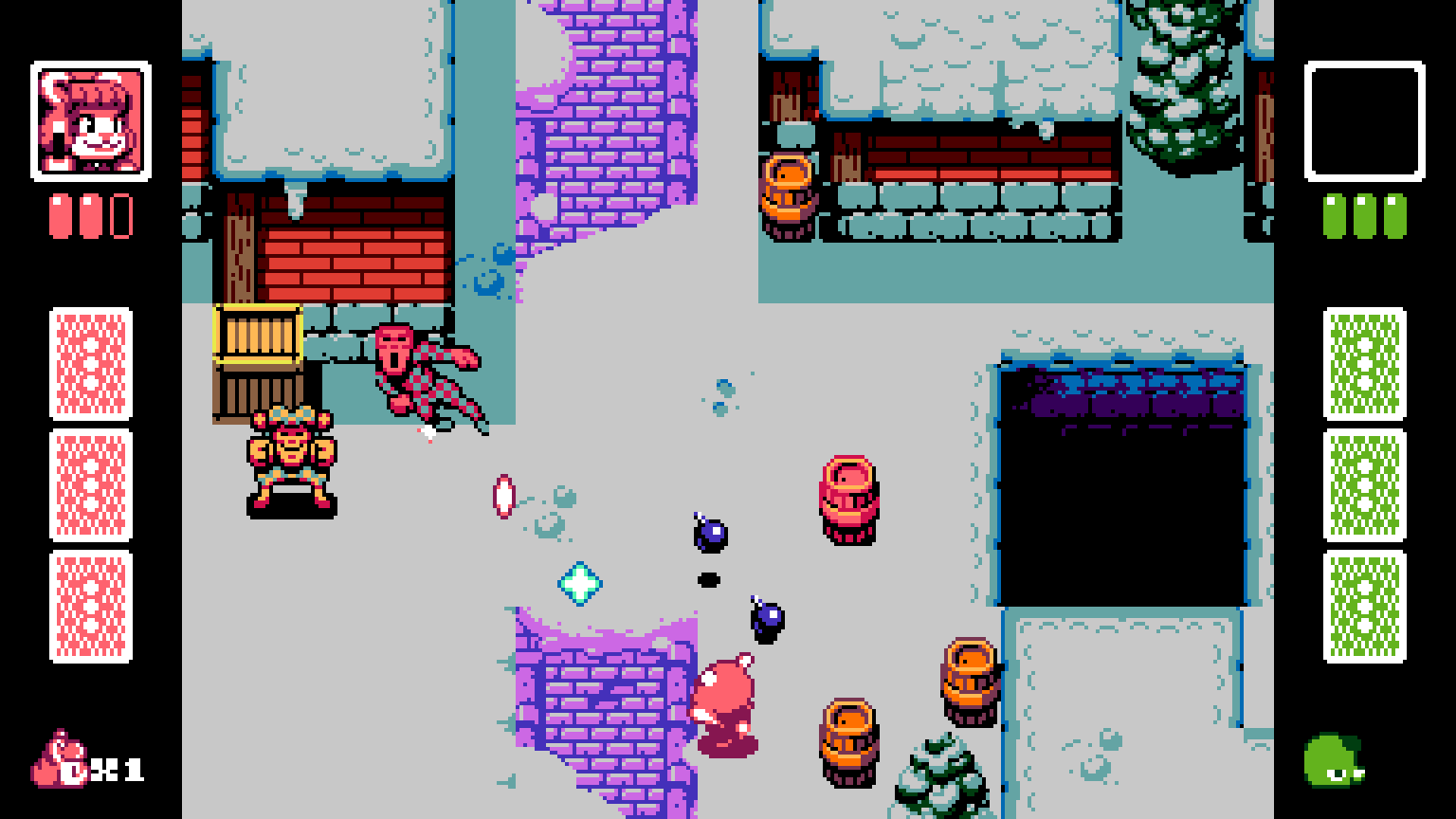
14. Elfazar's Hat
1988. Game #43. Real world director: Eirik Suhrke.This game tells the story of a bunny and a pigeon who rebel against the evil magician Elfazar, who's been using them as a part of his act against their will. The bunny girl that player 1 controls is the cutest character in the entire collection, and it immediately makes me biased towards Elfazar's Hat. This game is so cute.

This is the collection's co-op top-down shooter, a la Ikari Warriors or Pocky & Rocky. The problem with these sorts of games on classic consoles is typically the fact that without a dual analog stick controller you can only shoot in the direction you're moving, making it impossible to strafe or to back away while still shooting at an enemy. Elfazar's Hat solves this by simply locking your aiming in one direction for as long as you hold down the fire button (a feature that's standard across a few other games in the collection as well). This is complemented by a dash move that gives you invincibility frames to dodge incoming attacks. It mostly feels very fair towards the player—which is good, because man does this game throw a lot at you.
Meanwhile, the powerup system here revolves around cards with different symbols on them that enemies and breakable objects will drop. Match two symbols to get a weaker version of a power up, or match three to get the better version. It adds a nice bit of risk-reward strategy where you can either get a powerup sooner, which can help in a pinch, or hold out longer to get a superior upgrade. Within the fictional history of UFO Soft, this powerup system is seemingly meant to iterate on the one seen in their previous shooter Star Waspir, which is one of those little touches that elevates UFO 50 way past simply being a collection of 50 random 8-bit games.
Elfazar's Hat is a lot of fun and really polished, closer in its level of spectacle to something you'd see on 16-bit consoles than anything the NES could actually pull off, but unfortunately I think it's dragged down a bit by its lack of saving. You can continue from the beginning of your current stage as many times as you want, which is extremely generous for a game like this, but if you close the game you have to start over. It's not long, but it's juuuuuust long enough and the final stage is just difficult enough for this to feel like a pain in the ass to me, especially in a collection where playing something for a few minutes and then hopping over to something else is such a core part of the experience. On my first run where I actually got to the final stage I felt trapped, forced to either keep beating my head against the wall of the final gauntlet or abandon my run and play something else. (I eventually chose the latter.)
It's still a great little game, way better than the co-op top-down shooters you'd actually be able to play on 8-bit consoles. It's just that one point of frustration that keeps me from ranking it higher on the list. If you play it with a player 2, you'll probably have an easier time than I did.
On the complete opposite end of the tonal spectrum...
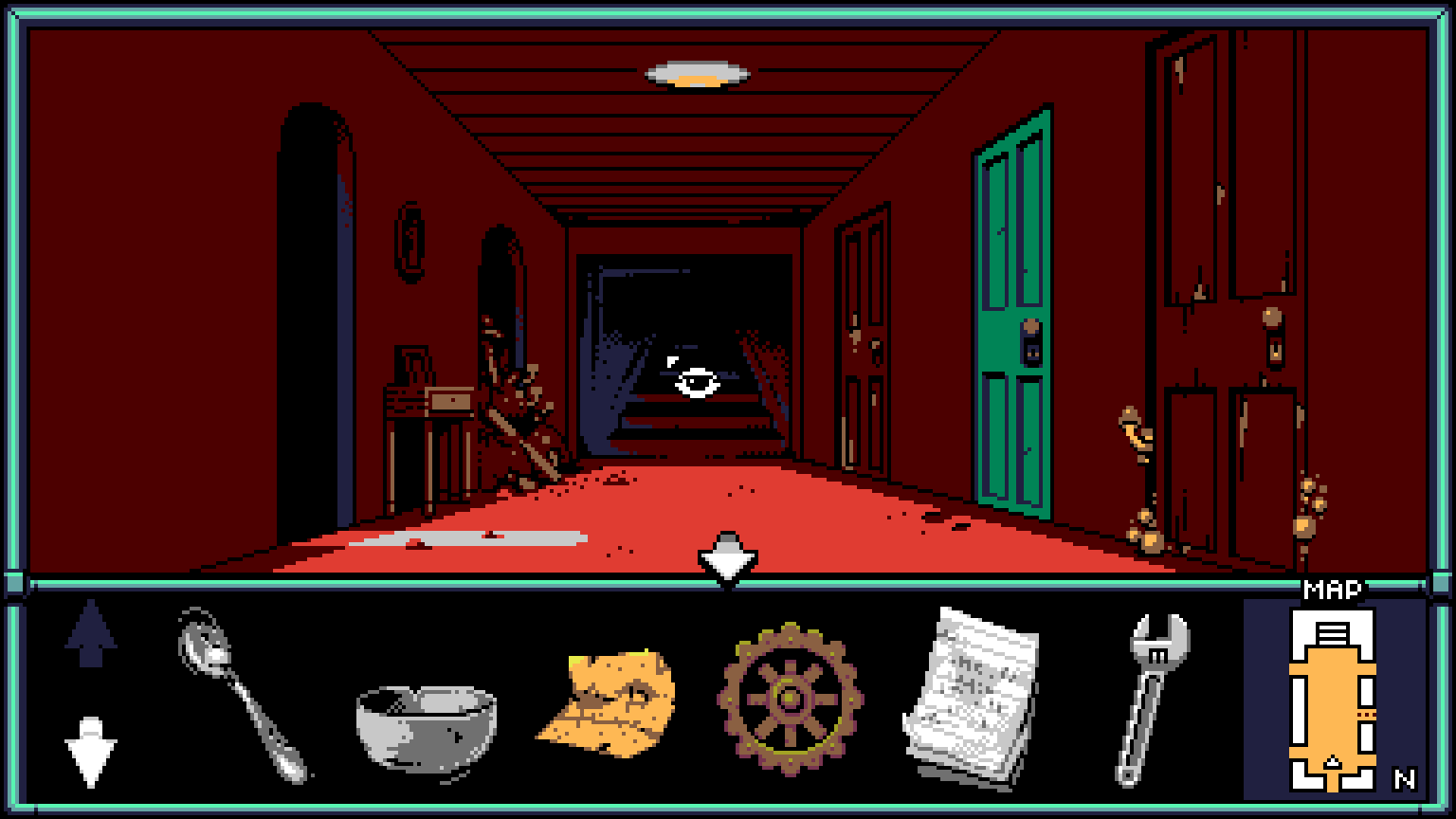
13. Night Manor
1988. Game #42. Real world director: Paul Hubans, with Derek Yu.This is a fairly standard (but good!) first person point-and-click adventure game, spiced up by its slasher horror theming. You roam the halls of a mysterious mansion, solving puzzles and piecing together the story of the horrible things that happened here, but the whole time you're also being stalked by the killer. (Just like Wendy Williams tried to warn us about.) When you encounter them, your cursor literally starts trembling, which is such a great touch. If you have a weapon in your inventory and you act quickly, you can try to fight off the killer to stall them, but otherwise you have to use your knowledge of the maze-like mansion layout to flee to safety and hide.
The tense and spooky atmosphere is great in this one, and the limited color 8-bit art style means that relevant details generally stand out fairly well on each screen, cutting down on pixel hunting. The puzzles have good "aha!" moments while also making logical sense. I'm not even much of a slasher horror fan, but I was so engrossed with this one that I played it for like an hour straight and got the bad ending in my first sitting. I'm sure some horror fans will consider this their favorite game in the collection.
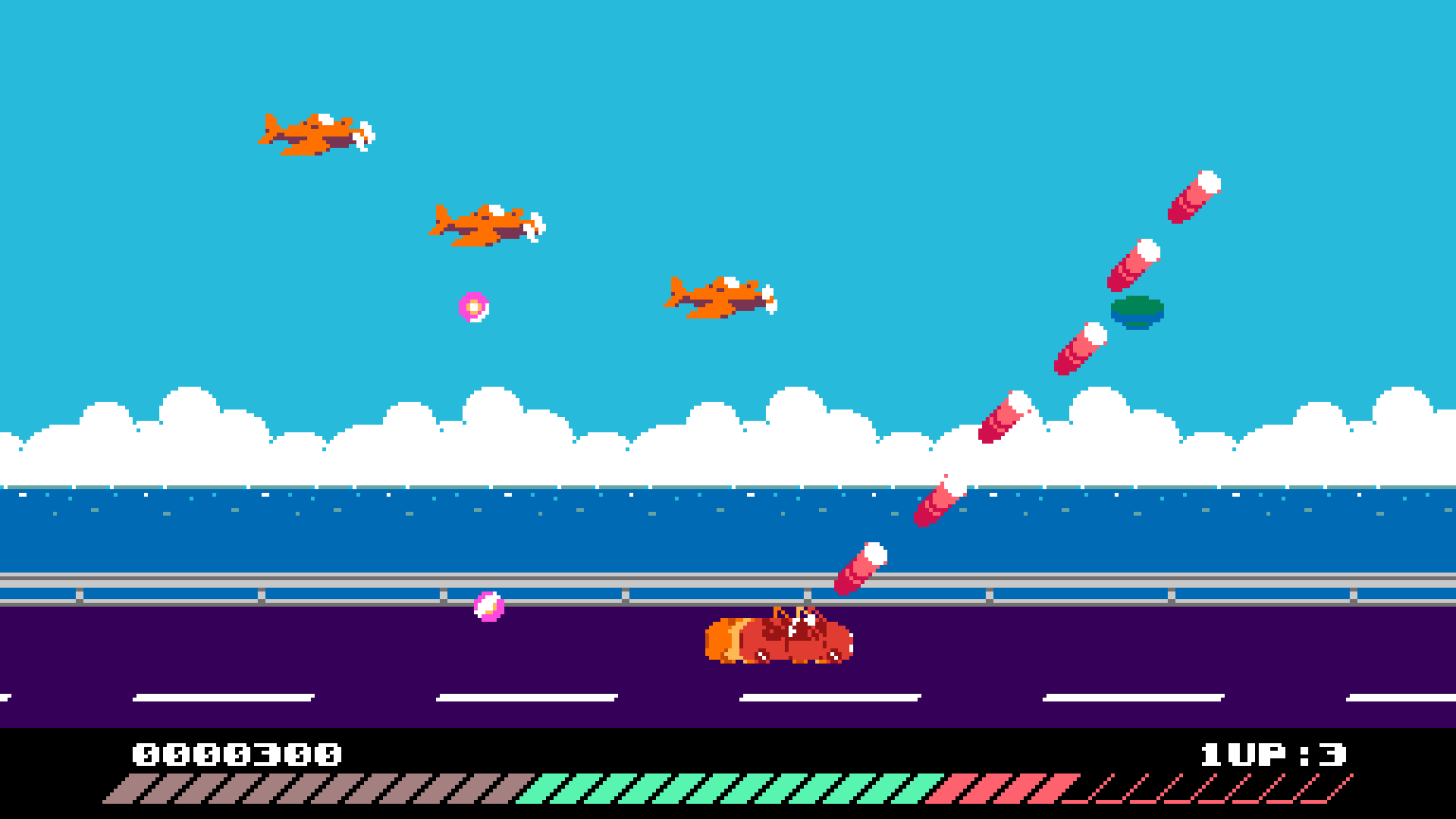
12. Seaside Drive
1989. Game #48. Real world director: Ojiro Fumoto.Easily my favorite of the shooters in the anthology. The vibe here feels sort of like the halfway point between Sega arcade classics Out Run and Space Harrier, although this is a purely sidescrolling game rather than a sprite scaling pseudo-3D affair. You play as an unnamed little guy in sunglasses going out for a scenic seaside drive in his cool red convertible, except also there are all manner of random bizarre enemies trying to kill you along the way.
At your disposal are both a gun that shoots upwards, which you can tilt at multiple different angles to fire across the screen, and a gun that shoots obstacles directly in front of you or behind you on the road. There's no real powerup system here, per se, because in its place you have a charge meter offering you three different levels of power for your guns. Driving forwards or shooting will drain this charge meter, while pulling back will cause you to drift and charge up. You basically want to be at max power at all times, which leads to a careful balancing act where you maneuver out of harm's way and then hang back to charge up whenever you have the room to do so.
It's a simple game, but an incredibly fun one with satisfying shooting. You can really tell this was one of the contributions from Downwell creator Ojiro Fumoto just from the way it feels. It's also got a great jazz fusion-y soundtrack, and the variety of increasingly strange enemies is fun—it makes sense that, within the fiction, this game was directed by an artist who was emphasizing the vibes and the visuals. It's somewhat challenging, but at only four levels in length (plus bonus stages if you clear a level without dying), it's short, sweet, and to the point.
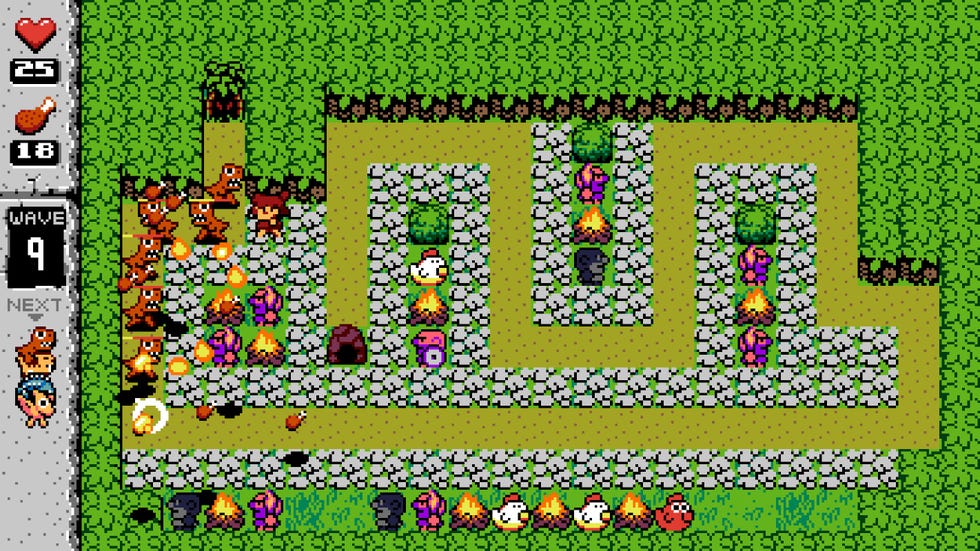
11. Rock On! Island
1987. Game #30. Real world devs: Derek Yu, Paul Hubans.Here's something you wouldn't have seen back in the '80s: an honest to god tower defense game!
Rock On! Island is a game where you place cavemen at strategic points on the map to defend their cave from wave after wave of dinosaurs. Defeated dinosaurs drop big cartoon hunks of meat, which can be spent to create more units. The base level caveman that throws bones can be upgraded to use either rocks, spears, or fire, and from there each of these has two higher level variants of their own. Aside from cavemen, you can also build campfires, which power up adjacent cavemen, or invest in chickens, which will give you back 30 meat after a couple turns spent cooking next to a fire. You have to choose how to use your limited space to carefully balance your offense, buffs, and meat investments, as simply spending everything on cavemen is a surefire way to lose.
Rather than using a cursor to place these units, you directly control an upgradable hero unit that can attack dinosaurs or run around and upgrade things mid-match—though if a dinosaur hits you, you have to respawn back at the base, losing a heart off of your base's health. This makes things feel very active, even in the early waves of each stage. The hero is often your most valuable attacker, but in later waves if you aren't actively building while the dinosaurs are attacking then you're wasting meat, as you'll quickly hit the cap of 99 meat. Again, it's a careful balance.
Unlike many tower defense games, which can be simple time wasters with dozens and dozens of padding rounds that pose no threat, Rock On! Island gives every level only a handful of waves that quickly ramp up in difficulty. There's no fast forward option here, and I couldn't even imagine it having one with how hectic things get after only a couple waves. Rather than feeling overly simplistic or stripped down, Rock On! Island works within its 8-bit limitations to feels like an all killer, no filler take on the genre.
And now, on to the proper top 10!
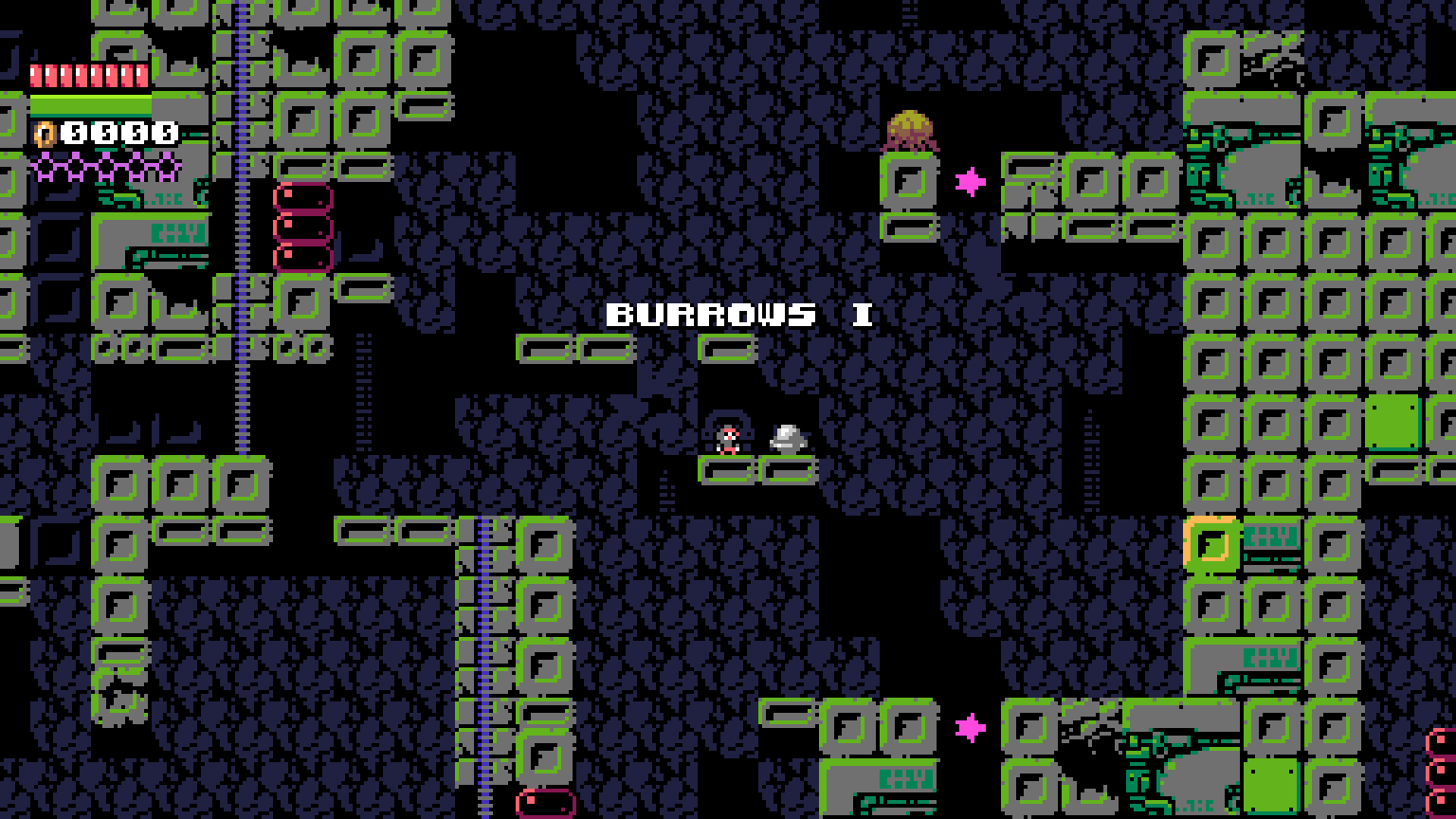
10. Campanella 2
1987. Game #35. Real world director: Eirik Suhrke.Unlike Nintendo or Sega, UFO Soft doesn't have a flagship platformer series. They were too idiosyncratic for that. Instead, their breakout hit that shaped their corporate branding is the Campanella series. All three games in the main Campanella trilogy are unified by the ability to fly around in a little UFO, but all of them do radically different things with this idea. And of the three, it's the odd and ambitious middle child starring the usual protagonist's sister that's probably my favorite.
The original Campanella was a simple arcade-style game about maneuvering your eponymous teeny tiny ship around single-screen obstacle courses, where bumping into the walls hurts you. Campanella 2 takes this idea and massively expands upon it, becoming sort of a roguelite take on Blaster Master in the process. While in your ship, you still fly around while trying not to bump into things, though rather than single-screen obstacles courses the game now consists of a series of larger randomly generated levels. And much like Blaster Master, you can now exit your ship and explore various zoomed-in sub-areas on foot. These usually take the form of short sidescrolling action stages capped off with your choice of reward, be it an upgrade or a refill for your health or fuel.
The main goal of each level is to fly around and collect ten stars, which will open up the exit and trigger a 60 second countdown to escape. Technically, this means you don't have to visit any of the sidescrolling sections in any level other than the one located at the exit, but making a beeline for the exit will severely cut down on your cash and upgrades. And you're gonna want those upgrades, because Campanella 2 is brutally difficult. You die after only a few hits, and you also typically crash and die if you run out of fuel, which is very easy to do if you dawdle too much.
I also want to shout out the music here, which creates such a different atmosphere from the jaunty little adventure the first Campanella was. The somewhat ambient theme for the first level, the Burrows, really sells the idea that you're exploring this weird and massive space station with its own unique ecosystem inside. It creates such a great vibe, like a weird old Amiga game or something.
Campanella 2 is great, is what I'm saying. Though if I'm being completely honest, I haven't even gotten past the second level yet, which is why I'm not ranking this higher. But I just feel so compelled to keep trying. I'm excited to master this game someday and find out what else it has in store for me.
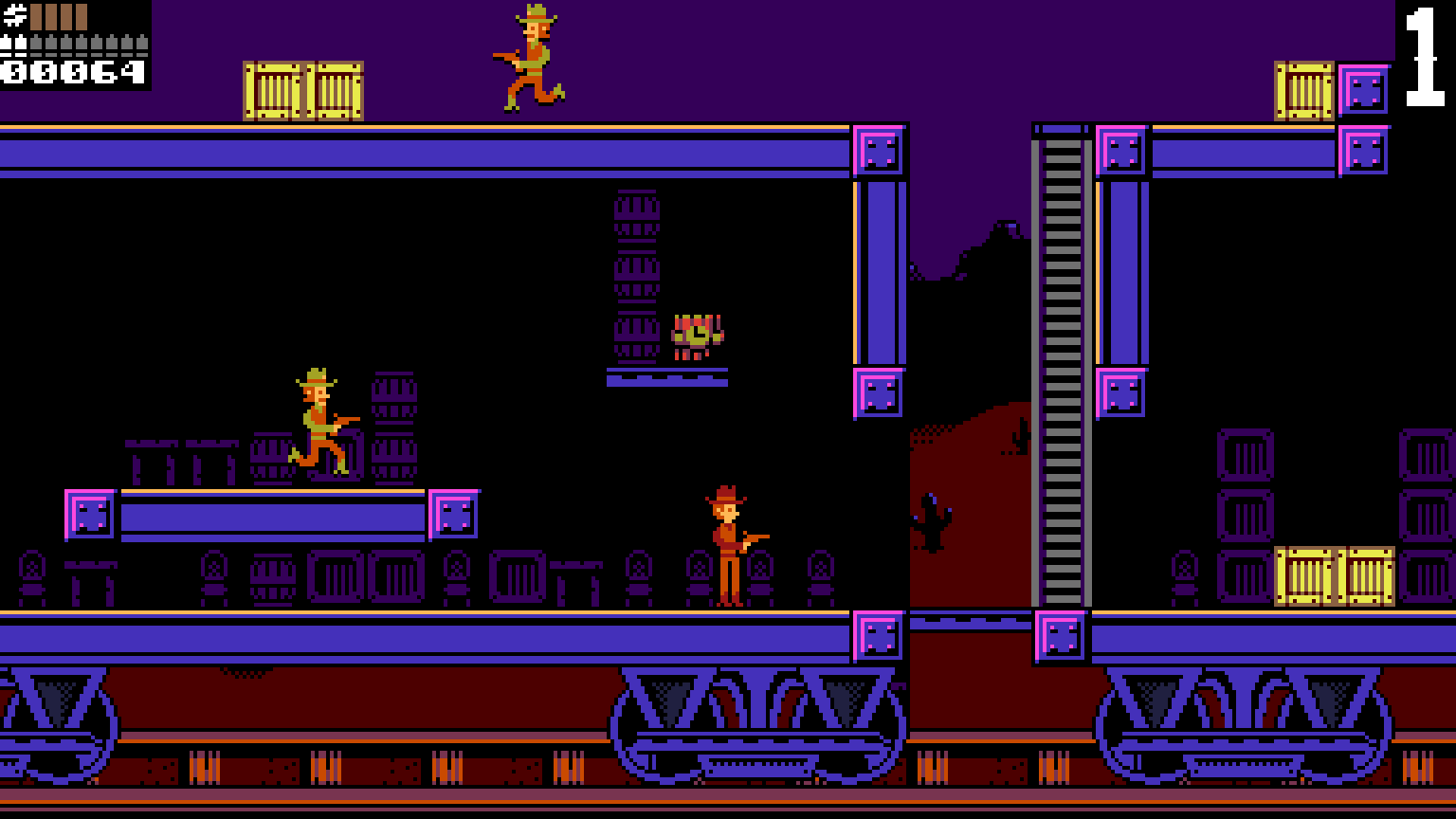
9. Rail Heist
1987. Game #28. Real world director: Jon Perry, with Paul Hubans.While it was originally designed as a head-to-head multiplayer game first and foremost, to me the singleplayer campaign of Rail Heist easily stands on its own.
Rail Heist is a cowboy train robbery game that takes the form of this... sidescrolling puzzle-platformer stealth 8-bit immersive sim thing? Boy, that's a mouthful. What it most reminds me of is Gunpoint, though this isn't a perfect comparison. The goal of each level is to steal the money on a train and then escape without getting killed by a lawman, but there are always a lot of different options for how exactly you accomplish this goal. You can use your limited ammo to shoot and kill the lawmen, or you can punch them to temporarily stun them. Maybe you'll find a chicken to toss at them as a distraction, or a crate to bonk them on the head with, or some TNT to blow them up with. Maybe instead of using the chicken as bait, you carry it with you for a gliding jump like Link would do. Maybe you punch your way through a wall to create your own shortcut. Maybe you manipulate the AI so that they shoot each other instead of you! It's up to you to figure out a strategy.
There's a catch, though. Once the lawmen are alerted, the game becomes turn-based. You'll have a few seconds to do what you want before being frozen in place, and then the lawmen get their turn to roam around and do whatever they're going to do. Since this is a simulation of what player 2 would be doing in the multiplayer mode, this means that the lawmen can also do most of the same things you can do. If at any point a lawman spots you, they'll shoot, and if you get hit you die. So just shoot them when they're not looking, right? Well, again, you have limited ammo, but also it takes a few seconds to load your gun, which really limits the amount of actions you can perform in a turn. On top of that, each level has an overarching time limit, so you really can't just take your sweet time. You've got to have a plan, but you've also got to be able to think on your feet and improvise based on what the lawmen do during their turns.
Rail Heist is another game I haven't gotten super far in, but it's just so damn cool. I'd be remiss not to name it as one of the best and most interesting games in the collection.
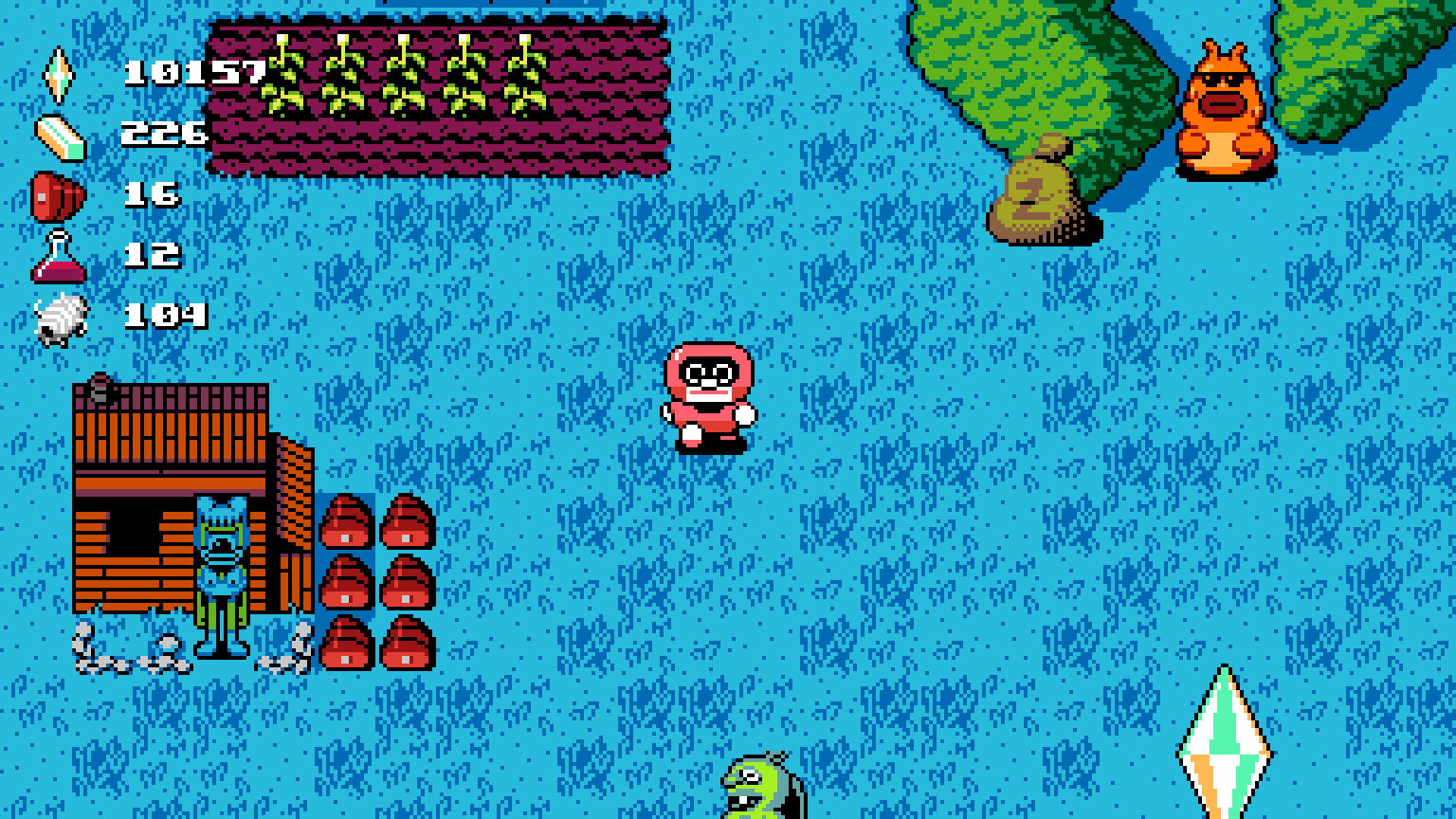
8. Pilot Quest
1988. Game #44. Real world director: Derek Yu, with Jon Perry.While UFO 50 presents its 50 titles more or less equally, it feels like the star of the show is the ambitious Campanella series spinoff Pilot Quest. (And not just because it's the game where you play as the company mascot from the title screen.)
Pilot Quest: Return to Zoldath is a clever mashup of two very different genres, being one part Zelda-like action-adventure game and one part idle clicker game. When the game starts, the Campanella crash lands on the planet Zoldath, the same setting from the earlier sci-fi adventure game of the same name. Pilot finds himself in a small camp where the basics of the idle game side of Pilot Quest are explained. Whack the crystal in the center of camp with your trusty yo-yo to acquire some moon drops, the game's most basic resource. Use your moon drops to plant some seeds, which will sprout into crops that automatically generate more moon drops over time. (More on that in a second.) Turn those moon drops into valuable moon ingots that can be used to buy more upgrades, or spend them on meat, which gives you the energy to venture out into the wilds... for a limited time.
Each hunk of cartoon ham in your inventory adds two minutes to your exploration timer as you investigate Zoldath in a top-down adventure that feels very reminiscent of the original Legend of Zelda. You're free to head off in any direction and explore whatever part of the map you want, completing the three dungeons containing the necessary parts to fix your ship in any order. There's very little in the way of extra equipment here beyond your yo-yo, so you'll never find any obstacles that require you to find a Hookshot or bombs or something to progress. But the thing is, the timer also doubles as your health meter. Take a hit and you'll lose 10, 30, maybe even 60 seconds off of the time you have to learn the layout of the map and gather valuable resources. And if you run out of time before you return to camp, you lose everything you've gathered.
I'll admit, I didn't quite "get" Pilot Quest at first. It felt like every time I ventured out into the world I either died or safely returned with maybe a few ingots and not much else, bringing me barely any closer to the upgrades I wanted. The time limits felt super tight, so I rarely wanted to venture out past a few spots with reliable loot right near the camp. (All of the treasure chests and pots and whatnot respawn with each trek out into the wilds.) Was it really just a massive grind for hundreds of ingots over the course of dozens and dozens of excursions?
Well, it turns out I was just playing it wrong. Here are my tips that I wish I'd figured out sooner:
- The world might seem dauntingly large at first, but it's actually fairly small—smaller than any top-down version of Hyrule. You can easily get from one end to the other in like a minute. There are also unlockable teleporters to help you get around even faster.
- Those piles of rubble on the ground in your base? I was waiting to be explicitly told to build something there, like with the meat shack in the tutorial. I thought maybe some of the upgrades the scientist NPC sells would put stuff there. But no, it turns out you can just walk up and inspect them to build stuff there whenever you want for really cheap. You can get those upgrades almost right away. Doing so will get you some workers to generate more resources, as well as more storage to increase your resource capacities. It took me an embarrassingly long time to realize this, which is why it felt like I had to grind forever for ingots!
- While the meat shack can only give you up to six piece of meat at a time, you can hold way more than that, which will really extend your time limit. You don't even need to find meat out in the wild to do this. Just buy out the current stock without actually leaving the base, step away from the game for a while, and come back to buy more once the stock is replenished. The absolute max is 25 meat, which translates to a whopping 50 minutes of exploration. This is more than enough time to comfortably clear all three dungeons in one outing, especially if you have an upgraded yo-yo to kill enemies faster. I know this because I literally did exactly that on my second playthrough, just to see if it was possible. I took a bunch of damage and still made it back with about nine minutes to spare, and I even went out of my way to do a side quest, too!
Wait a minute. Stepping away from the game? Yes, this is the real genius of Pilot Quest to me: its clock is still ticking and resources are still being generated for you when you're playing other games in the collection! Though these resources do have a cap, so you can't just put Pilot Quest down for ten hours and then come back with everything you need to instantly win. You have to keep checking in. This makes it the perfect game to check up on every now and then while you're jumping from game to game. Maybe an excursion in the wilds ends badly, and you step away to play a few rounds in one of the more arcade-style games to see if you can top your high score, or make a little more progress in one of the RPGs, and then you come back half an hour later when your resources are replenished and try again. This is what elevates it past being merely a quirky sci-fi Zelda clone with a funky soundtrack and makes it a long-term experience that unifies the whole collection.
(On a similar note, I'd also like to give a shout out to Porgy, the other game about venturing out from your home base and trying to return safely with loot before time runs out. That's sure to be a favorite for a lot of people, especially thanks to its cute cartoon submarine protagonist and its exquisite undersea vibes, though it didn't click for me quite like Pilot Quest and its idle game mechanics did.)

7. Mortol II
1987. Game #32. Real world director: Derek Yu.One of the early standouts in UFO Soft's library is Mortol, a dark fantasy sidescrolling platformer with a grim sense of humor where each of your lives is technically a different character, and you can strategically sacrifice your guys to use them as projectiles, platforms, or bombs and make life easier for your next character. I like Mortol a lot, and I see why it's one of the most popular UFO 50 games, but personally it's the sequel that really blew me away.
Rather than a series of linear stages, Mortol II lets you loose in one big, nonlinear level and lets you tackle your objectives however you see fit. And rather than having one character type who can be sacrificed in multiple different ways, every time you die you select a new character from a list of five classes with specific abilities. There's:
- The sword-wielding Soldier, who can turn into a stone block to serve as a platform or push down a switch.
- The Gunner, who can turn into an ammo pickup for future Gunners and other classes with ranged weapons.
- The wrench-throwing Engineer, who can turn into a vertical pipe through the ground at the point where they're sacrificed.
- The agile Scout, a ninja who leaves behind a teleporter between the home base and the location of their death.
- And the Bomber, whose only function is to explode and deal a bunch of damage.
Of course, there's one big limitation: you only have 99 lives total.
Within the fiction, Mortol seems to have been conceived by Benedict Chun as a dark satire with an anti-war message, emphasizing how easily human lives are taken for granted. I mean, it's a game where the heroic faction is literally just throwing bodies at their enemies in the name of "saving their nation." But this message was softened against his wishes in the first game by letting the player gain extra lives back. No such luck here! 100 years have passed since the first game, and despite the good guys winning in the first game nothing's gotten better, so now it's time to start another conflict. We've got 99 disposable guys champing at the bit to sacrifice everything for their country, and many of them are going to die completely pointless one-hit deaths that don't accomplish a damn thing. It's "how did your great grandpa stepping on a landmine protect this country": the video game! And when you're out of guys, that's it. Everybody's dead. They lost. The end.
...Uh, anyway, I swear Mortol II is a fun time.
There's a decent chance your first run of Mortol II will end unsuccessfully with a lot of wasted lives, and you'll have to start all over again. (And maybe your second, and your third...) Maybe you'll feel like you've hit a brick wall and you go play something else. But that's okay, because knowledge of the map is the most powerful tool at your disposal. The key here is to scout things out, learn where the key points of interest are, suss out a route to unlock the door to the final boss, and figure out the most strategically advantageous places to leave shortcuts via the Engineer's vertical pipes and the Scout's teleporters. But, of course, every shortcut you create eats into your life count, creating a constant push and pull.
Eventually, once you know your preferred route to the final boss and the most advantageous places to sacrifice your troops, you'll put it all together into an actually successful playthrough of the game. And then maybe you try again and again to do it with fewer deaths. And maybe eventually you're good enough to speedrun the game in a mere two minutes. It's great. Though, if I'm being honest, there's another punishing game about learning the best route through its nonlinear map that I had an even better experience with in UFO 50. More on that in a bit.

6. Magic Garden
1984. Game #5. Real world director: Derek Yu, with Jon Perry and Tyriq Plummer.Of the simpler arcade-style games in the collection, this is the one I kept going back to the most. To most players, it will probably be overshadowed by the more ambitious games, but man do I like this one.
Magic Garden is a riff on the timeless time waster Snake that adds a few simple but interesting new layers for a greater sense of risk and reward. The basic goal is to travel around the screen collecting little Puyo-looking guys called "Oppies," which follow you around in a chain, and then deposit them in marked zones. These zones shift around the play space when you score (or after enough time has passed, if you take too long to score). The longer the chain, the more points you earn when you deposit it.
Over time, enemies will spawn into empty spaces around the garden, which you have to avoid by walking around them—or jumping over them with precise timing, if you're feeling brave. Attempting to drop off Oppies that aren't on top of the designated scoring areas will also turn them into enemies, which makes longer chains more dangerous. Touch an enemy even once, or run into the edge of the screen, or collide with your own chain of Oppies, and it's game over.
However, after saving at least six Oppies, a potion powerup will spawn, which temporarily allows you to clear out enemies a la Pac-Man's Power Pellet. Saving longer chains of Oppies and surpassing that minimum of six will even get you better potions that will give you a 2x score multiplier while clearing out enemies. The key to high level play, then, is to intentionally let your field fill up with enemies so that you can rack up insanely long potion combos. (Getting a long combo in this always reminds me of Pac-Man Championship Edition DX, which is about the best possible thing an arcade-style score chaser game like this can remind me of.) The fact that the game ends when you save 200 Oppies only seems to reinforce this. Beating the game only got me the second highest score on the board, so truly conquering Magic Garden seems to require you to become a potion combo sicko to maximize your score on the way to 200 Oppies.
It's certainly challenging, but it feels incredibly fair due to some smart design decisions. Enemies have a long animation where they grow in size as they spawn in, and before moving they stop their idle animations for a couple seconds and look in the direction they're about to go, so if you're paying attention there's always ample warning for where enemies will be. The potions have a timer at the top of the screen, meaning you know exactly when you're about to lose your invincibility so that you don't run into an enemy and die at the last second. New enemies stop spawning while a potion is active, and any enemy that was in the process of spawning will immediately grow to full size so you can defeat it. The player character doesn't even increase in speed over time or anything like that to artificially inflate the difficulty. It's not about having insane twitch reflexes or good luck, it's just about focusing and not losing your cool. Anytime I die in Magic Garden, it feels like it was my fault, not the game being cheap.
And that's it! That's pretty much all there is to the game. It's simple arcade fun at its finest, nicely complemented by cute art direction. There's not much to it at first glance, but those extra risk/reward wrinkles make it surprisingly compelling. I kept turning on my Steam Deck for a round or two of Magic Garden, or playing it as a palate cleanser between the more complex games, and I had fun with it every time.
(Also, the little ending after you get 200 Oppies is cute.)
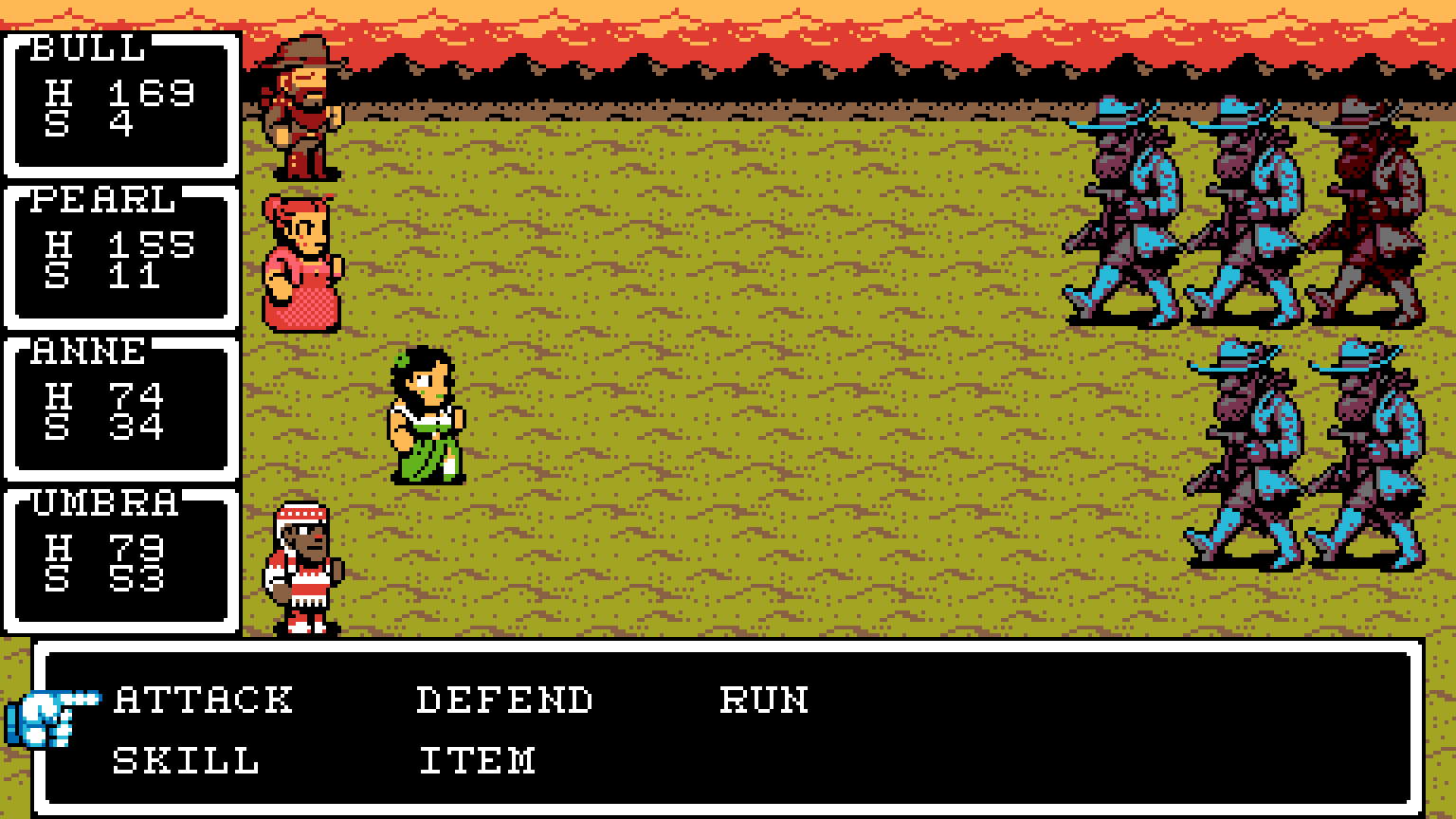
5. Grimstone
1988. Game #40. Real world director: Derek Yu, with Paul HubansGuess what: there's a whole-ass RPG in UFO 50. Multiple, actually! The other turn-based RPG, Divers, is the dungeon crawler about deep sea diving lizard people that I mentioned up top. But the one that I really enjoy is, predictably, the one that plays like Final Fantasy.
Grimstone wears its inspirations on its sleeve, though it has three main things going for it to differentiate it from FF.
Number one: It has a wild west theme. Yes, the underappreciated Live A Live also had a cowboy segment, but this is a whole-ass cowboy RPG. And it's great. It's set in the same world as Rail Heist, actually, and one of the train robbers from that game reappears here as a potential party member. In the fiction, Grimstone was in development for quite some time, and Rail Heist was a spinoff project that just happened to get finished and released first due to its significantly smaller scope.
When playing the collection chronologically, though, this ordering leads to a great bait and switch—if you'll allow me to "spoil" some early story details from Grimstone. See, Rail Heist makes it seem like the setting here is just the regular old American frontier. Nothing seems out of the ordinary. But as soon as you start Grimstone, things start to feel odd. All the horses look emaciated. The rivers on the overworld map are all red... Perhaps a stylistic choice? Maybe the water is reflecting a sky that seems to be permanently stuck at sunset? That's an awfully large canyon... are we on some kind of floating landmass? Wait, didn't they say something about angels and demons in the opening? And why is the currency in this game teeth?
Pretty quickly, you realize that the opening narration wasn't being figurative when it said that the characters had been "suffering in Hell." The game is literally set in Hell. Cowboy Hell.
Number two: Combat features a simple timing minigame when attacking, a la the Mario RPGs, which makes things slightly more active if you're into that. While I'm of the belief that western devs doing JRPG throwbacks often rely too heavily on timing mechanics like this to "liven up" classic turn-based combat systems without actually doing anything interesting with them, often just slowing down the combat, I like the implementation here. As you might expect given the setting, the weapons tend to be guns rather than swords and staves, and each type of firearm has its own timing on the QTE bar that appears when attacking, as well as their own advantages and disadvantages. For example, many revolvers will let you fire at your target multiple times per turn, while shotguns sacrifice their ability to do critical hits for high base damage and splash damage to adjacent enemies. It's quick and simple so that it doesn't drag out the fights, but it adds a little bit of extra flavor to the different attacks to make every class of weapon feel distinct.
And number three: the party selection. I won't spoil exactly how it plays out, because I think it's really cool, but the opening of the game presents you with eight different characters and tells you to select up to four of them to build your party. You don't get a rundown of all their abilities or their stats or anything, just a brief vibes-based description. And then that's it. Decision made. That's your party. It's up to you to figure out what exactly your party members do over the course of your adventure. They start out with no real abilities, but over time they grow into spaghetti western spins on classic RPG archetypes like the tank, the thief, the healer, etc.
I think this is incredibly cool, though this setup is a major point of stress for many players. I've seen people say they bounced off of Grimstone because they thought they'd picked a "wrong" party and locked themselves into a bad playthrough. I understand this fear—it's similar to the stress over whether or not my build is "right" that's made me bounce off of every Souls series game I've tried. But the truth is that every party member in Grimstone is good and viable. Some just take longer to reveal their strengths than others. You can also, of course, just look up community guides to see what each party member does before you make your selection, but it really doesn't seem like there are any wrong choices here, and a big part of the fun is just going along for the ride.

Really though, Grimstone is one of the most traditional games in UFO 50. It's a pretty straightforward take on the genre. But that's also one of the reasons why I like it so much!
There's no shortage of new JRPGs out there inspired by the classics, whether they're new efforts from the big Japanese studios or indie throwbacks. (I literally made one of those myself!) But most of the high profile examples are trying to evoke the big hits of the mid-to-late '90s like Final Fantasy VI and Chrono Trigger with their more complex stories and lavish set piece moments, not their simpler 8-bit predecessors. And the modern Square Enix throwbacks are barely even trying to capture the snappy pacing of the classics, favoring longer battles, more dialogue, and additional layers of progression and character building to better match modern expectations for the genre.
But Grimstone completely nails what the best console RPGs of the late '80s and early '90s actually played like in a way that I rarely see today. Fights are quick, with the challenge coming from long-term attrition as individual encounters chip away at your resources, and you're never in one location for too long before you're ready to move on to the next. Sure, sometimes you might wanna grind some, but putting in a little forethought and going into a boss fight with full health and some useful items is usually more than enough to turn the tide. Toss in the cool Cowboy Hell theming and you've got yourself a real winner.
My sincere hope is that people picking up the collection will give Grimstone a chance, and that it might be some peoples' gateway into old-school JRPGs. Many balk at any mention of the word "grinding," turning away from a game they might otherwise have loved because they believe that they're incapable of playing any game that "makes them grind." The irony is that 10 minutes of level/gold grinding here and there in an old school JRPG is treated as this insurmountable obstacle, this cardinal sin of game design, but 10 hours of filler side quests and grinding for rare drops in a modern JRPG is treated as a sign the game gave you your money's worth. But I hope that Grimstone is juuuuuuuust approachable enough to open peoples' eyes to the appeals of the old ways of doing things.
Honestly, the main thing keeping me from ranking it a bit higher? I still need to finish it. Again, it's a whole-ass RPG in a collection of 50 games! But I adored what I played.
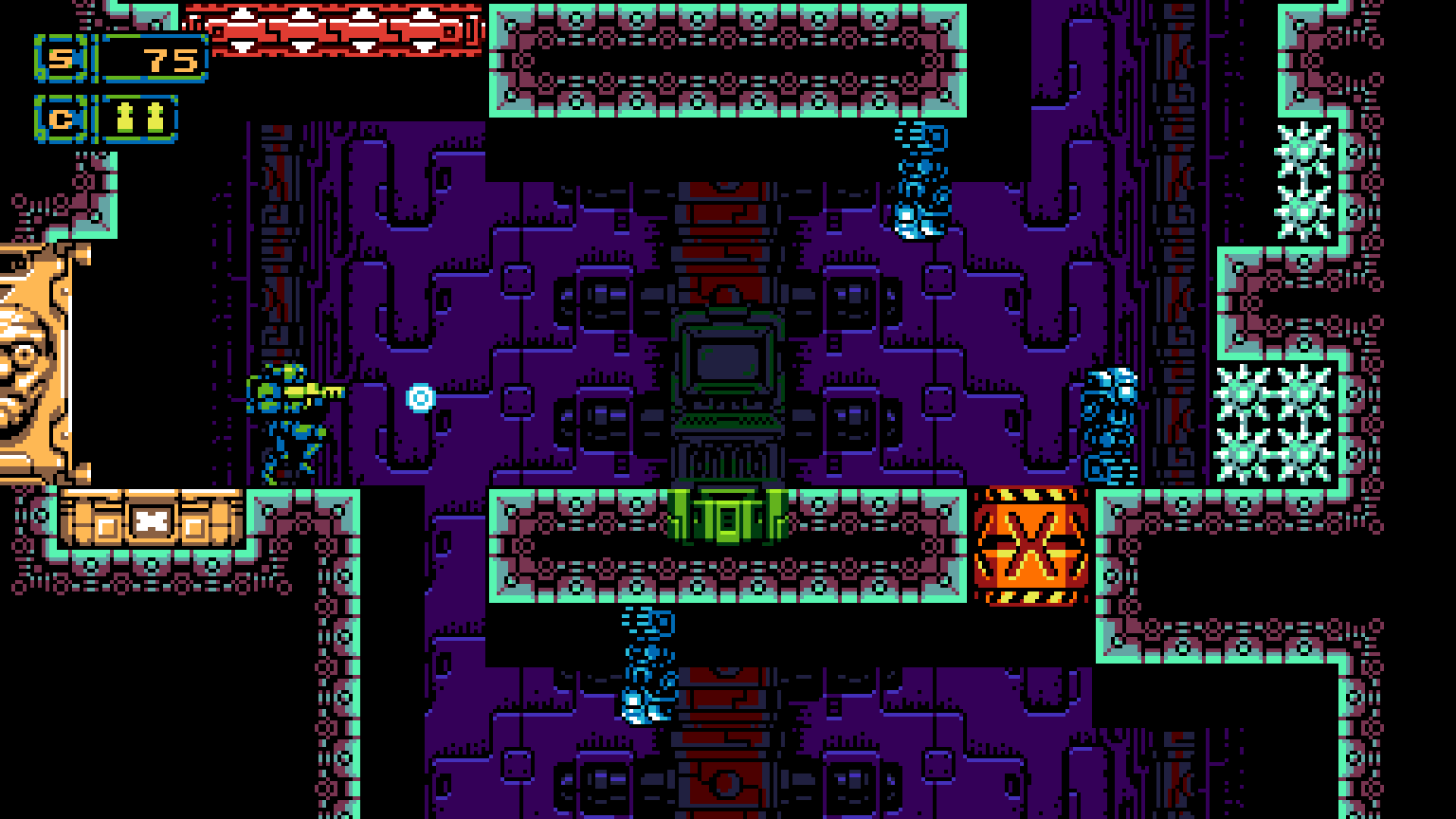
4. Vainger
1987. Game #29. Real world devs: Derek Yu, Tyriq Plummer.I've already discussed several nonlinear sidescrolling action games that could be lumped into the Metroidvania umbrella here, but Vainger is by far the game in UFO 50 that fits the traditional image of that genre the best. By that, I mean it'll remind you of Super Metroid. However, it still has some really cool ideas of its own that make it well worth checking out.
The main gimmick of Vainger is its gravity-flipping mechanic. If you've played games like Metal Storm or VVVVVV, this will probably be familiar territory. Hell, it's not even the only game in UFO 50 with gravity manipulating mechanics, as earlier in the list you'll encounter Warptank, a puzzle platformer where you control a little tank that can zip between the ground and the ceiling, or from wall to wall. (Warptank is also very good, and just barely didn't make it onto this list.) The main difference from those other games is that in Vainger you're free to repeatedly flip gravity in midair to hover in place, which I find very fun. The behavior of the first boss outright encourages you to do this, clinging to the walls in a long vertical shaft that makes it hard to hit from the ground or ceiling.
What I find more fascinating, even though it's brought up less, is the way Vainger handles upgrades. The main upgrades you'll find on your adventure are four Mods (Heat, Multi, Pulse, and Force). At any checkpoint, you can choose whether these mods are equipped to your gun, your armor, or your gravity flipper for different effects. For example, the Heat Mod makes your shots more powerful and adds a fire effect when equipped to your gun, reduces your damage taken and gives you heat resistance when equipped to your armor, or makes inverting your gravity create a fire shockwave effect when equipped to your gravity flipper. You can only have one of these upgrades at a time, so you'll never have your entire kit of abilities available. It's up to you to experiment with different combinations and determine which are the best tools for the challenges ahead of you.
On top of this, your equipment will malfunction if you equip multiple Mods to the same piece of gear. You can find a couple stabilizer upgrades that will negate these penalties... but if you're really good, you can just tough it out and deal with the extra damage. UFO 50 really is full of cool little risk/reward decisions like that.
Beyond these twists, Vainger is just an all around solid Metroidvania, with level design somewhere between that of Super Metroid and Mega Man, really nice late era NES-style sci-fi scenery, some of my favorite music in the anthology, and a cool suit of armor for the main character that reminds me of Kamen Rider. It's an easy recommendation all around...
...unlike my #3.

3. Barbuta
1982. Game #1. Real world director: Eirik Suhrke.If you've played Barbuta, either you're nodding in agreement right now or you think I've lost my goddamn mind.
This is surely the most divisive game in the collection. It's also the first game in the collection, described in the fiction as a hobby project secretly created on company time by Thorson Petter back before the studio was even making video games. (At this point in the story, UFO Soft was still a business software company known as LX Systems.) And you sure can tell it's supposed to be a game from the early '80s developed by one guy for a machine that wasn't optimized for games yet. It's, shall we say, an acquired taste.
Barbuta is a proto-Metroidvania about a dopey little knight exploring a maze-like castle, comparable to something like Maze of Galious (perhaps best known today as the game that inspired La-Mulana), except even more archaic and alien. Despite being developed by UFO 50's composer, there's no music, just some sound effects and a faint buzz every time the game has to load a new screen. You move at a snail's pace and have a rigid, floaty jump, with controls roughly as responsive as the original Donkey Kong. Your attack is this dinky little sword with hardly any range, which will probably get you killed at least once before you get used to the spacing. Enemies don't even show any sign they're taking damage when you hit them, which will initially make you wonder if your stupid sword actually does anything. While you respawn on the same screen after dying, you start the game with only six extra lives, and if you run out you have to start the game over. And most players will probably get stumped on where to go and how to make any progress and quit within ten minutes. It was a real shock to the system after being told for years that UFO 50 would have a lot of modern design sensibilities. It's a deeply frustrating game.
And that's exactly why Barbuta got its hooks in me.
Placing it first in the collection is both an incredibly bold choice—people have absolutely returned UFO 50 on Steam after having a bad first experience with Barbuta—and a stroke of genius. It benefits so much from the anthology format. I probably never would've purchased Barbuta on its own, but when bundled with a bunch of other games that are more straightforward in their appeal I was at least willing to give it a shot. And then as I jumped from game to game, my first experience with Barbuta kept lingering in my memory. What was that game's deal? How did it even expect me to progress past those first few screens? That can't really be it, can it? I'd go back every once in a while, try to chip away at it a little more, and get another game over. It's like the game was taunting me, egging me on to solve its riddles. But anytime I made even an inch of progress it felt like a huge breakthrough. Real world designer Eirik Suhrke described it in an interview with PC Gamer as a game trying to get players to defeat it out of spite, and boy, he sure nailed it.
Eventually, I played and fell in love with another game in UFO 50 where taking notes felt like it gave me an advantage, and this activated the part of my brain that enjoys note-taking while playing games. And so came my big game changer with Barbuta: I started making a map. This initially started as a simple spreadsheet with notes on what could be found in each screen of the castle, but before long I moved over from my Steam Deck to my computer so I could just start pasting together screenshots to make a proper map.
Once I really started making progress in Barbuta, I realized that it's actually kinder to players and more open-ended than it initially lets on. For one, several of the upgrades required to explore more of the castle can be found in multiple places. There are also (at least) three different ways to reach the final boss and beat the game, with the most straightforward brute force option allowing you to completely skip the game's most arcane puzzle solutions. (And even then, I only had to look up a walkthrough for two very specific things, both of which made me go "oh, duh" when I saw the solution. There's nothing anywhere near as crazy as La-Mulana in here.) Really, it becomes a game about figuring out an optimal route through the castle and knowing which item pickups you do and don't need, which making a map really helped with. And, yes, it's frustrating to die and have to start over, but retreading the same ground really helps burn the castle layout into your memory. Even the slow walk speed is kind of a boon, giving you plenty of time to look around and notice visual clues in each room rather than just sprinting through them. And it's not like it's a long game. I spent about six hours total with it, and my final successful run only ended up taking about 24 minutes. But man, when I finally did it, it was so, so satisfying.
Barbuta is absolutely not going to be a game for everyone, but it's an experience I'm very glad I had. There's a certain deadpan quality about it that became very appealing to me, once I learned how to meet it on its own terms. And it's thanks to this anthology format that I was open to giving it a shot. That's the magic of UFO 50.
Also, the moral of Thorson Petter's story is that time theft is awesome.
I debated for so long where exactly to rank this. There are many other games that are easier to recommend, that I had more "fun" with, but Barbuta is one of the most creatively interesting games in the anthology and it lives in my head rent free. I have to be honest with myself here. It's #3. But it wasn't until I played this next game that I started to "get" Barbuta.

2. Mooncat
1985. Game #13. Real world director: Eirik Suhrke, with Ojiro Fumoto.Mooncat was the first game in the anthology that really confirmed to me that UFO 50 is something special.
After a moody opening portraying the oddly-shaped, armless, faceless, seemingly newborn creature that serves as the protagonist beaming down from space into the world, the first thing players will notice in Mooncat is the controls. You start in a room with no threats so you can figure out the basics in peace, but most players will probably get confused, pause to check the guide for the controls, and realize that it literally just labels the four directions of the d-pad and the two face buttons with "move". You have to figure out on your own how to walk or jump. Soon enough you'll probably realize that pressing an input, any input, on one side of the controller will make the creature walk left, while pressing the inputs on the other side will make the creature walk right. (Which side does what will depend on which control type you picked on the title screen.) Over time you'll realize that other combinations of inputs let you do other moves, but early on just figuring out how to walk and jump (done by pressing inputs on both sides simultaneously) is a major hurdle.
This might make Mooncat sound like a gag game like QWOP or something, but I really think there's something here. Mooncat harkens back to a time from before video game control schemes were considered a solved problem, from before you could pick up just about any game and safely assume what buttons make you move, jump, and attack. The controls are our physical connection to the world of a game, and sometimes doing something different and creative with them makes the experience more interesting. Think back to all the playful ways Ape Escape made use of the second analog stick before it was standardized as the camera stick, for instance, or the way you flick the yo-yo around in Penny's Big Breakaway. Hell, even outside of genuinely creative stuff like this, sometimes it's just fun to go back to an old game with kind of a clunky control scheme for a change. I'm a weirdo who found Mega Man Legends and its mandatory tank controls way more of a fun learning experience than Mega Man Legends 2 and its standardized dual-stick inputs. It can be a change of pace that makes you more actively engaged with what you're playing, since you can't just press the buttons on autopilot.
This odd control scheme isn't Mooncat's sole appeal, but it's hard to imagine the game without it. It so perfectly puts you in the shoes of the mysterious protagonist, a newborn creature that doesn't understand anything about itself or the world around it. The arc of the player coming to terms with the controls and figuring out how to maneuver and survive forms a sort of implied character arc for the creature learning how to control its own body. Over time you'll realize that the levels are arranged pretty perfectly to allow you to chain moves together with a steady rhythm, but before you can schmove, you must learn to schwalk. This vibe is compounded by the framing story, which is largely up for interpretation, and the atmosphere created by the music and pixel art. It's a harsh world full of death traps where gravestones and skeletons are common sights in the background, but it's also a beautiful one. That moment where I first got to the forest and the music started playing is just one of those evocative video game moments that'll always stick with me.
The other thing you may notice about Mooncat up front, if you read the descriptions for every game, is that in the fiction of UFO Soft it's supposed to be a spiritual successor to Barbuta that Thorson Petter spent two years perfecting. This might not make sense at first since the games seem to have very little in common, though over time you'll notice some implied connections. What they mean is up to you.
The real connection is just both games' love of secrets and letting players discover things for themselves. Progressing through the increasingly tricky platforming challenges and getting to the end will get you a final boss fight (which, admittedly, is really basic and kind of annoying—this is my biggest criticism of Mooncat) and a perplexing ending. But exploring the levels further will lead you to all sorts of secrets, including alternate routes through individual screens and secret warps to entirely different routes that will lead you to different endings.
Years ago, the iconoclastic indie game collective Arcane Kids put out their own personal manifesto, and the line from it that's always stuck with me is "the purpose of gameplay is to hide secrets." If he was a real person, I think Thorson Petter would feel the same way. (Maybe he'd also like some other lines in the manifesto like "art isn't about giving people what they want" and "bad is more interesting than good," too.) Mooncat's whole design philosophy of having a steep initial learning curve but actually being rich with secrets and alternate routes to aid the curious player made me go back and look at Barbuta in a whole new light. These are games that force you to meet them on their level, but once you do, you realize how much they're willing to work with you. Starting Mooncat up for the first time and realizing that it was Thorson coming into his own as an artist, capturing the vision he had for Barbuta in a beautiful new way... it's great. It was my Frank Reynolds "oh my god, I get it" moment of UFO 50. All of that was always there in Barbuta, I just couldn't fully see it until I fell in love with Mooncat.
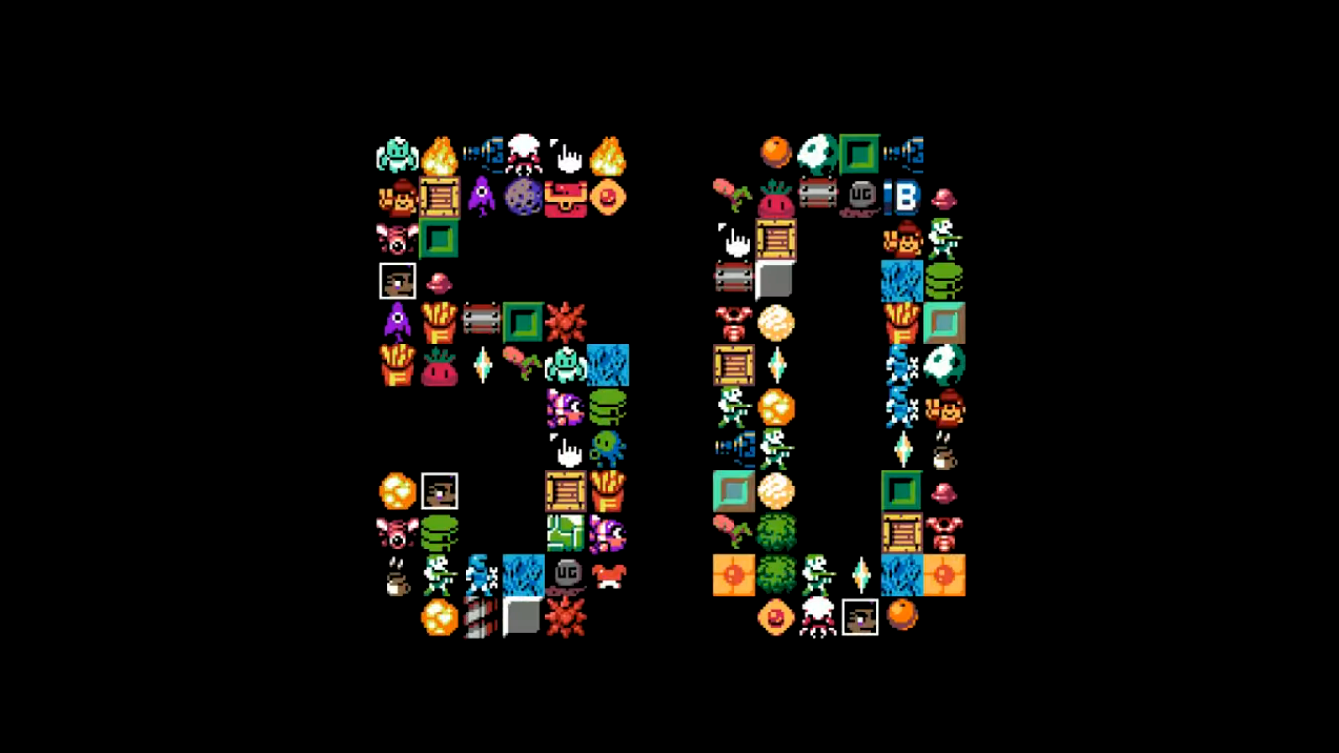
Other honorable mentions
There are simply too many good games in this collection, and my personal tastes don't do justice to the sheer variety here, so here's a slew of honorable mentions before we get to #1.
Velgress (game #7)
A simple vertically-scrolling roguelite platformer that I'm affectionately nicknaming "Upwell." You hop between crumbling platforms to climb up out of a giant pit, shooting enemies that get in your way and collecting coins to buy a few upgrades between levels. Like Magic Garden, I keep finding myself going for a round or two between other games. Its follow-up Overbold, a Smash TV-esque top-down shooter where you can increase the difficulty of the next round to earn more cash for upgrades, is also very fun.
Avianos (game #12)
Strategy games aren't really my thing, but I wanted to shout out the very fun theming here. This game is set in a post-apocalyptic world where humanity has nuked itself to extinction and birds have evolved to take our place, having reached their own medieval society of dopey little bird guys. At the beginning of each turn, both sides pray to a different mythical "ancestor" to determine which actions they can take and in what order—and said ancestors are, of course, all dinosaurs.
Bushido Ball (game #14)
This is probably gonna be a fan favorite for people who enjoy the 2-player versus modes in this collection. It's a samurai-themed sports game somewhat reminiscent of cult classic Windjammers or indie favorite Lethal League. If you're not familiar with those, imagine if Pong was a fighting game. The goal is to hit the ball into your opponent's edge of the screen, but alongside your basic melee attack each character also has unique projectiles for zoning and super attacks to mix things up, and you can also do a dodge roll to try and quickly catch the ball, AND hitting the ball in different ways can put different spins on it. I'm sure with the right people this could be hours of fun.
Party House (game #25)
A deck building management game where you expand your rolodex of potential guests for your house parties. Letting them in one by one in random order, you've got to try and balance the guests' fun with a steady cash flow, and avoid letting them cause so much of a ruckus that the neighbors call the cops. Make some cash and you can expand your house to host more guests with their own special effects, and hit your overall goals within a set number of nights to win the scenario. I totally get why this is the most beloved UFO 50 collection in some corners of the internet.
Valbrace (game #37)
This seems like a very traditional first person dungeon crawler at first, but when you encounter enemies it transitions seamlessly into over-the-shoulder real-time combat. The big, detailed sprites and the gameplay where you strafe left and right, block, and move in to attack when your enemy is open make it feel sort of like a Punch-Out!! dungeon crawler RPG. Very cool. This very likely would have made the list proper if I'd invested more time in it.
Lords of Diskonia (game #41)
The aforementioned strategy game where you take turns hurling your disc-shaped units around the field like it's an air hockey table. It's just such a unique concept that I have to highlight it here.
Quibble Race (game #47)
I haven't put much time into this one, but it's kind of incredible that there's an alien horse racing gambling simulator in here. You can bet on which Quibble will win each race, train your own Quibble, or risk paying shady alien thugs to sabotage your competitors behind the scenes. The quick rounds and potential for cartoon slapstick shenanigans as you spectate the races probably make this a good party game, too, with support for up to three players. Umamusume, eat your heart out.
Cyber Owls (game #50)
The final and most technically advanced game in the collection, meant to be a tie-in with a Teenage Mutant Ninja Turtles-esque cross-media franchise. (The development blurb says it was released alongside a comic adaptation.) You control four anthropomorphic owls, each with their own stage with its own completely different playstyle - a sidescrolling action game, a Metal Gear-inspired stealth game, an auto-scrolling shooter, and a Wild Guns style shooting gallery. If you get a game over as one character they'll be captured by the enemy, and you have to choose another character to go and rescue them via a special tactical mode. It's a neat game with a lot of polish, but it leaves me wishing there was a whole game for each of the playstyles. Though... maybe that's on purpose? It seems to be going for a maximalist style of design, painting a picture of a hubristic company that was chasing trends and emphasizing flashy variety over depth, assuming that this would be the recipe for a huge new property. And then they immediately went out of business.
(Similarly, some of the UFO Soft lore makes me wonder if the most widely disliked game in the collection, CombatAnts, was made to kind of suck on purpose, reinforcing the narrative that its lead dev was an egotistical hack. There really is so much to dig into with the metanarrative stuff.)
And now, without further ado... my favorite game in UFO 50.
If you've played it, you may have seen this coming.
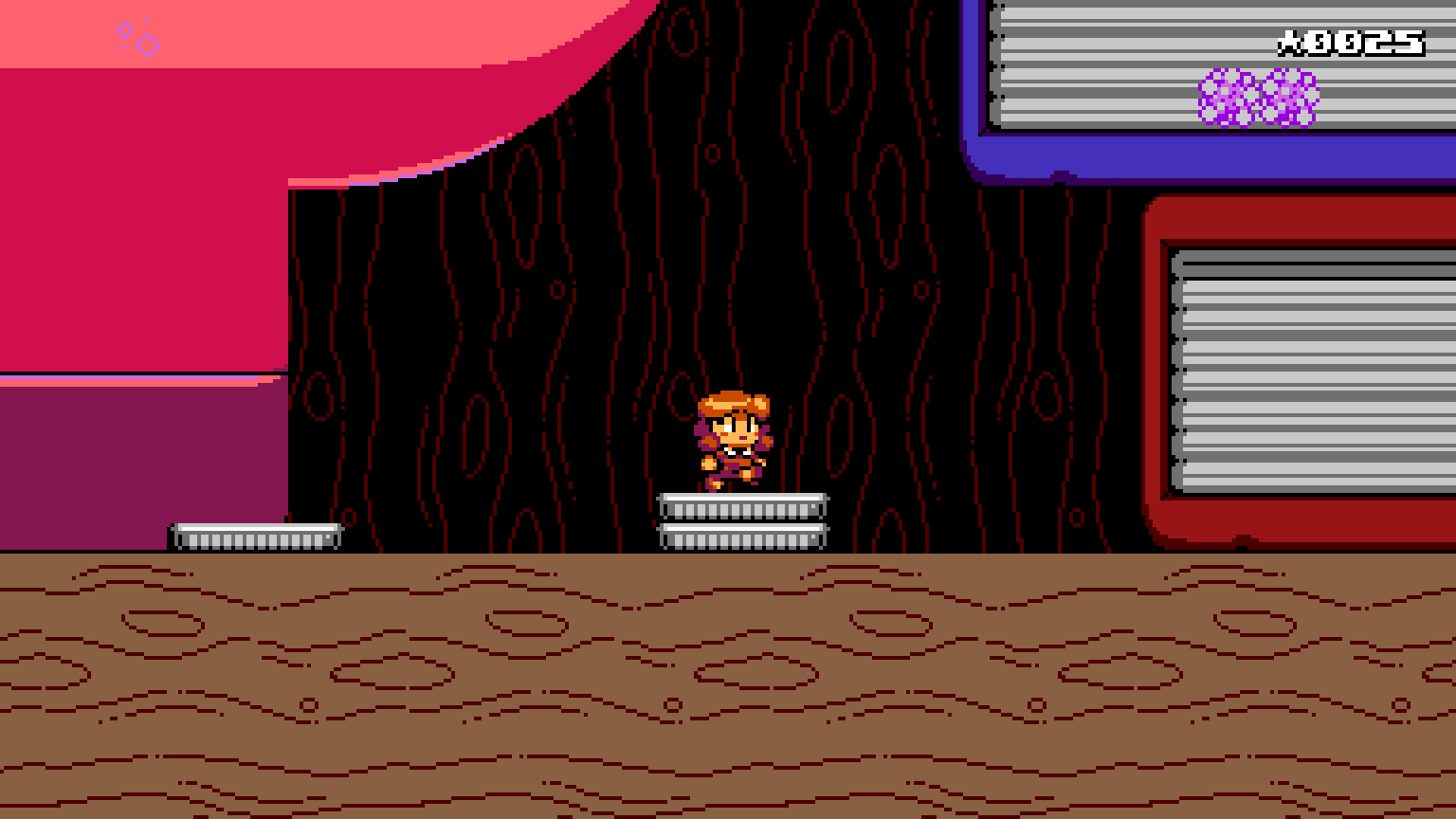
1. Mini & Max
1989. Game #45. Real world director: Jon Perry, with Paul Hubans.UFO 50 is jam packed full of great games, but without a doubt the game I had the best experience with is Mini & Max. I am not exaggerating when I say this game changed my relationship with retro games.
First, the premise, since Mini & Max is one of the most story-driven games of the collection. The game tells the tale of a young girl named Mini and her dog Max. One day, while her mother is away, Mini's selfish older sister locks the two in a storage room so that they won't bother her while throwing a house party. Enraged, Mini pitches a fit and smashes a mirror. After a couple hours spent being bored, Max—who can apparently speak—brings up the idea of shrinking down to slip under the crack in the door. He suggests just crouching down and "thinking small thoughts." Lo and behold... it works! They shrink down, but instead of an easy exit they discover a whole microscopic realm where the shattering of that mirror has had world-changing consequences.
The interesting thing about the premise, to me, is that it feels like the plot of a children's novel. A kid with a troubled relationship with a family member discovers a world of magic that the adults just never stopped and noticed, presenting her with an adventure where she gets to sort out her feelings along the way. It reminds me a bit of Where the Wild Things Are, and it made me consider for the first time that, even though tons of video games are aimed at kids, especially games from the '80s, very few attempt to emulate children's literature like this. It's rare to see a game riffing in the same literary space as Maurice Sendak or Beverly Cleary. It feels surprisingly unique.
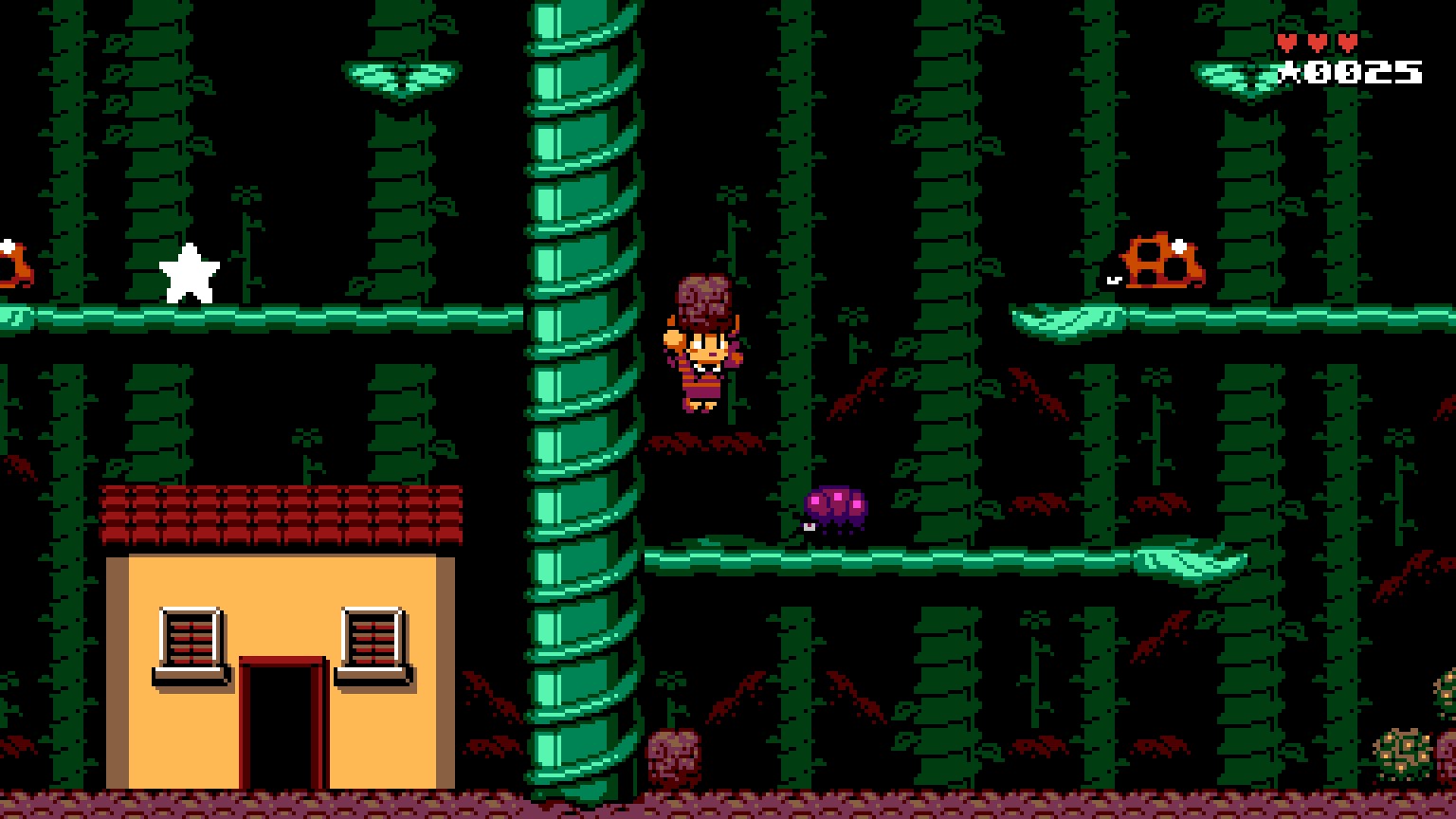
Anyway: shrinking! Mini & Max is another Metroidvania of sorts, though it might be easier to just call it a "platform adventure" game. What seems to be a small room at human scale becomes a sprawling world when shrunk down. (Well, sprawling by NES sidescroller standards, anyway—I completed the game in about six hours.) Because you can shrink anywhere in the storage room and go right to the equivalent location in the miniature world, you're basically free to explore wherever you want right from the start. Maybe you find a warren of dust bunnies, or a war being fought with army toys, or a bunch of bugs living in a potted plant, which feels like a jungle at that scale. You can also return to normal size at any point to use the normal-sized room as a sort of fast travel hub, making getting around super easy and making death a brief inconvenience at worst.
At this risk of sounding cliche, this is very much a game structured in the vein of Breath of the Wild. You're dropped into the middle of a large world, and an elderly NPC early on will tell you where the final boss is. In this case, the goal is to get inside the doorknob so you can unlock the door and leave the storage room—which, coincidentally, is also where the main antagonist has built their palace. But how you get there, and how prepared you want to be when you confront that final boss, is up to you. You can make a beeline for the ending, or you can explore every nook and cranny of the world to find optional but useful upgrades and gear. And if it looks like there should be something interesting somewhere, there probably is. It's an incredibly rewarding world to explore, full of fun new surprises and additional layers of depth around every corner.
The action here is focused around picking up and throwing things, not unlike Super Mario Bros. 2—or perhaps Capcom's Chip 'n Dale Rescue Rangers would be the more apt comparison, given the scale. The platforming is very basic, but the game makes great use of the fact that you can pick things up and take them just about anywhere in the world, especially once you get the backpack upgrade that lets you store an item or two without needing to hold it above your head. Are enemies annoying you? Go find one of the items that works like a POW block and bring it with you. See something that's a little too high to reach? Just find some blocks to stack up. Or, once you find the very cool upgrade that lets you command bugs, just find a bug that jumps high, crawls up walls, or flies, and use it as a mobile platform. You'll also find upgrades for your dog Max, who functions sort of like an item. You can pick him up and throw him, you can ride on his back and use him as a platform, you can even have him sniff out items for you. Like with several of my other favorite games in UFO 50, there's a variety of tools at your disposal, and the way you tackle these challenges is largely up to you.
But the low-intensity platforming and action feel like they're in service of the real heart of the game: exploration and quests. It's a sizeable world full of NPCs who give little hints about where you might find something interesting, or ask you to bring them an item found somewhere in the world, in the tradition of classic 8-bit adventure games and RPGs. In fact, there's so many of them spread out all over the place that it can quickly become overwhelming. I'm being vague to avoid spoilers here, but sooner or later you'll learn that there's even more to the world than what there initially seems to be. It's frankly way too large of a world to aimlessly wander around without a specific destination in mind. You'll just get lost.
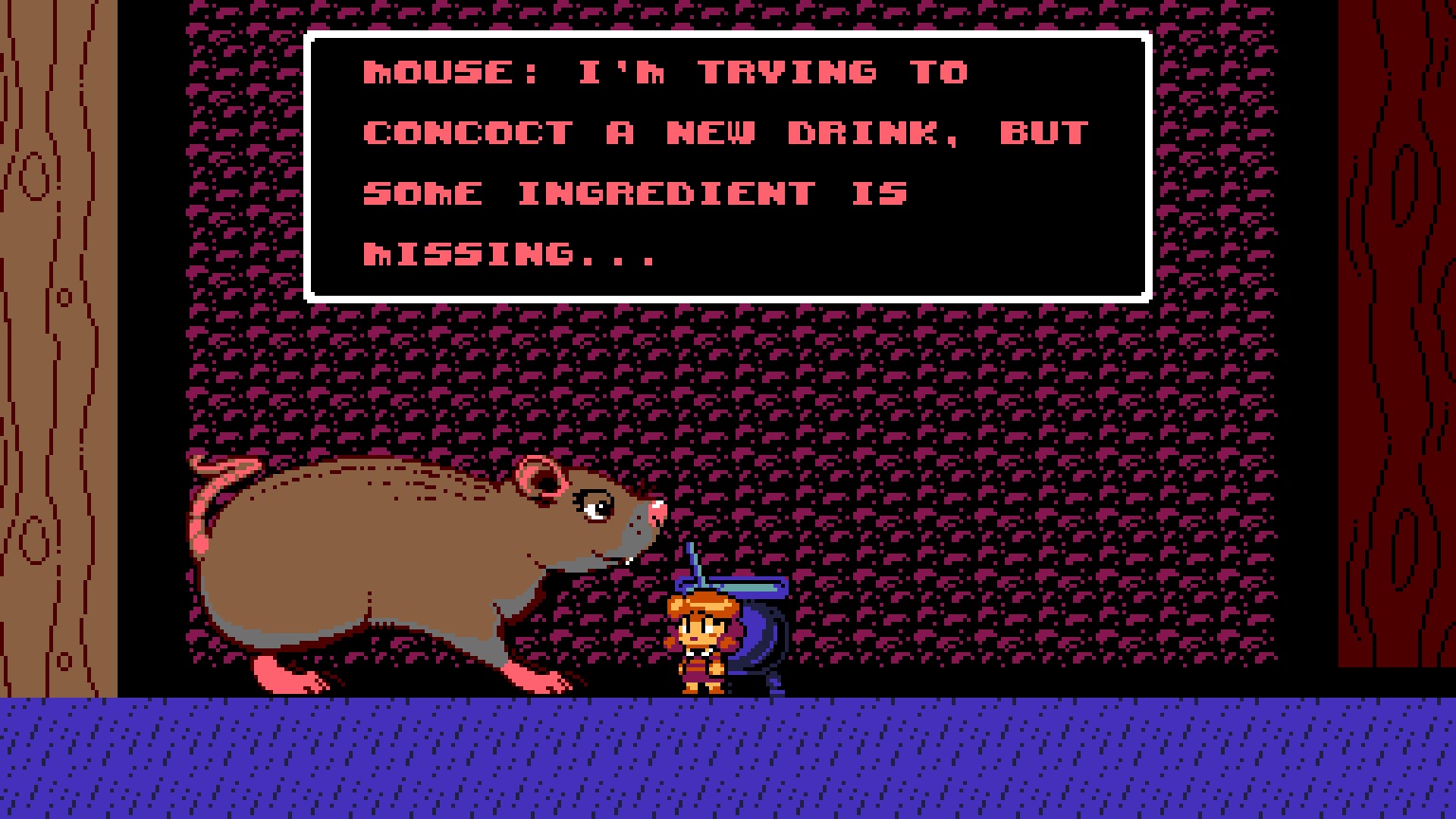
But here was the big game changer for me, the thing that completely changed my experience with Mini & Max: I realized I should be taking notes.
This might seem really obvious. Like, duh. Of course you can take notes while playing a game. I've done that before! Some of my favorite games are ones I had a great time with specifically because I had so much fun taking notes while trying to decipher their most cryptic puzzles, like the aforementioned La-Mulana, or Fez. But it usually takes something crazy like that for me to bust out the notebook. I'd never thought about the possibility of doing it in one of these old-fashioned games where NPCs are always telling you stuff like "I heard there's a secret hiding at the bottom of the well in Frundleton." That's not an elaborate puzzle I have to solve with a pen and paper like Fez's rune translations. You just have to remember what the NPC said. But I don't always remember what they said, is the problem! Especially not in a game as open-ended as Mini & Max, where at any given time you can be juggling hints for like a dozen different fetch quests with very little direction on what you should do next. It devolves into an ADHD nightmare.
So I made a text document on my computer and started keeping track of these leads to remember what all I was supposed to do at any given time. I basically made my own quest log. Maybe some would look at that and say it's "bad" or "outdated" game design, and that the game should just include a quest log and an in-game map to keep track of this information for you. But you know what? I had way more fun doing it this way! It made me way more engaged in the adventure, as I was proactively choosing on my own to record these clues rather than just mindlessly talking to every NPC and knowing that the game would remember the important shit for me. When I felt lost, I'd consult my notes, and I'd almost always realize there was something I'd overlooked in an area I'd already been to and feel really clever for having written it down in the first place.
This experience has stuck with me. A few months later, I played through the original Phantasy Star for the first time. Early in the game I got lost and wasn't sure how to progress, but rather than either quitting the game or just looking up a walkthrough and letting it tell me what to do, I thought back to my note taking in Mini & Max. And so I went around to all the NPCs in the starting towns and wrote down all the hints they gave me. Sure enough, the path forward became clear. I kept up my note taking for the entire rest of the playthrough, and once again, I had a great time doing so. I really, truly cherish Mini & Max for instilling this lesson in me, because I feel like it opened up a whole new world of classic games I can give another shot. Mini & Max is a phenomenal game on its own, but it's this perspective-changing experience that will make me cherish it forever. And all because it doesn't have a quest log!
Mini & Max isn't quite the last game UFO Soft made within the fiction, but to me this is their swan song. It feels like the culmination of everything Thorson Petter set out to do with Barbuta, letting you learn the ins and outs a strange new world full of secrets and surprises. Along the way it homages several previous UFO Soft games, even implying that Mini's sister is throwing one of the parties from Party House while all this is happening, making it feel like a celebration of the company's back catalog. While there are still good games after this, none of them can compare to the scope and ambition and sense of adventure here, or the delight it made me feel every time I made a new discovery. This is the climax of the library, and everything else is the denouement. A few final personal projects like Seaside Drive and Quibble Race. A jank strategy game, CombatAnts, that seems to have been the unwanted brainchild of a boss nobody liked. A "back to basics" third game in the Campanella series that actually plays nothing like the previous Campanella games, trading in the careful maneuvering and the experimental roguelite format of the sequel for an action-packed space shmup that mostly seems to be a showcase for its faux-3D graphics. And, of course, there's Cyber Owls, the trend-chasing franchise that was dead on arrival. Truly, UFO Soft peaked with Mini & Max.
It's just so, so special. It's both classic and new, familiar and fresh, a game that feels excitingly huge but doesn't overstay its welcome at a tight six hours, a game built off of a deep understanding of '80s game design tropes that feels like it could have only been made today. It's the perfect encapsulation of what makes UFO 50 so great.
And those are my favorites! Put them all together and you get my favorite game of 2024, and one of the best video game experiences I've had in a long time. It's not often I can say I came out the other side of a game with my relationship to the medium fundamentally altered, but I really do feel like I have a greater appreciation for weird and opaque old games, as well as short arcade-style high score chasers. It's not just nostalgia. There's genuinely still magic in this school of game design, if you open yourself up to it. I'm so glad that it's available on Switch now so that more people can experience it for themselves.
Of course, even at over 12,000 words, I feel like I've barely been able to scratch the surface of the collection here. If you've played UFO 50 yourself, feel free to share your own personal favorites in the comments below!


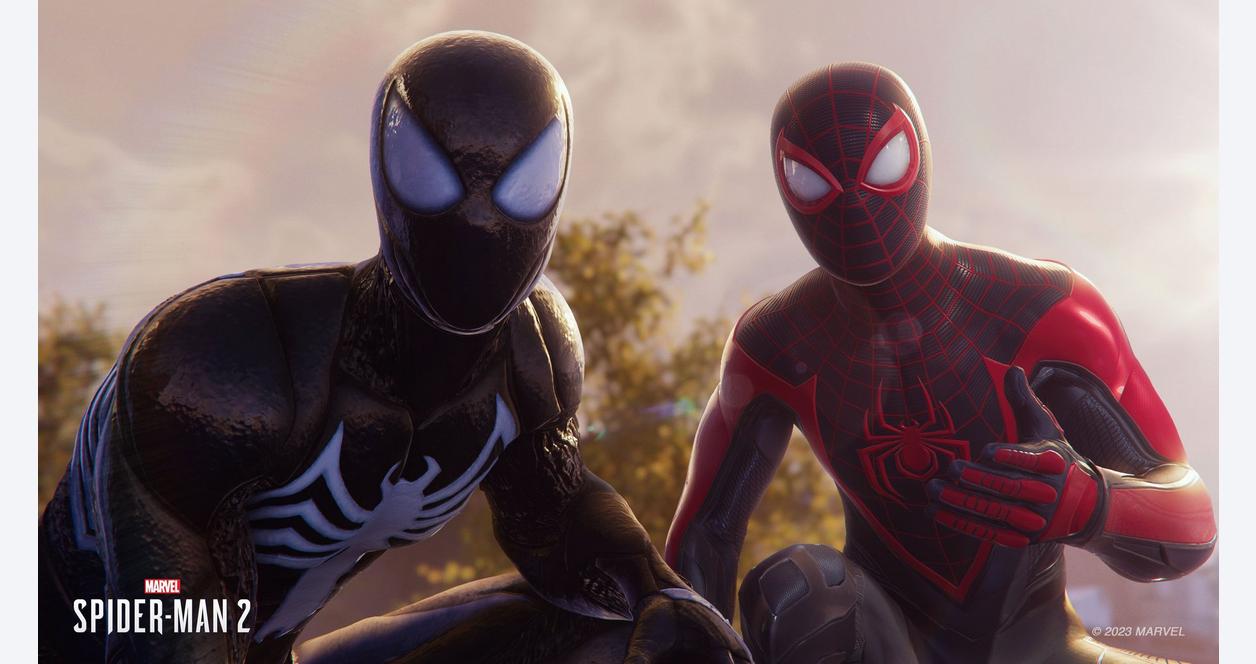
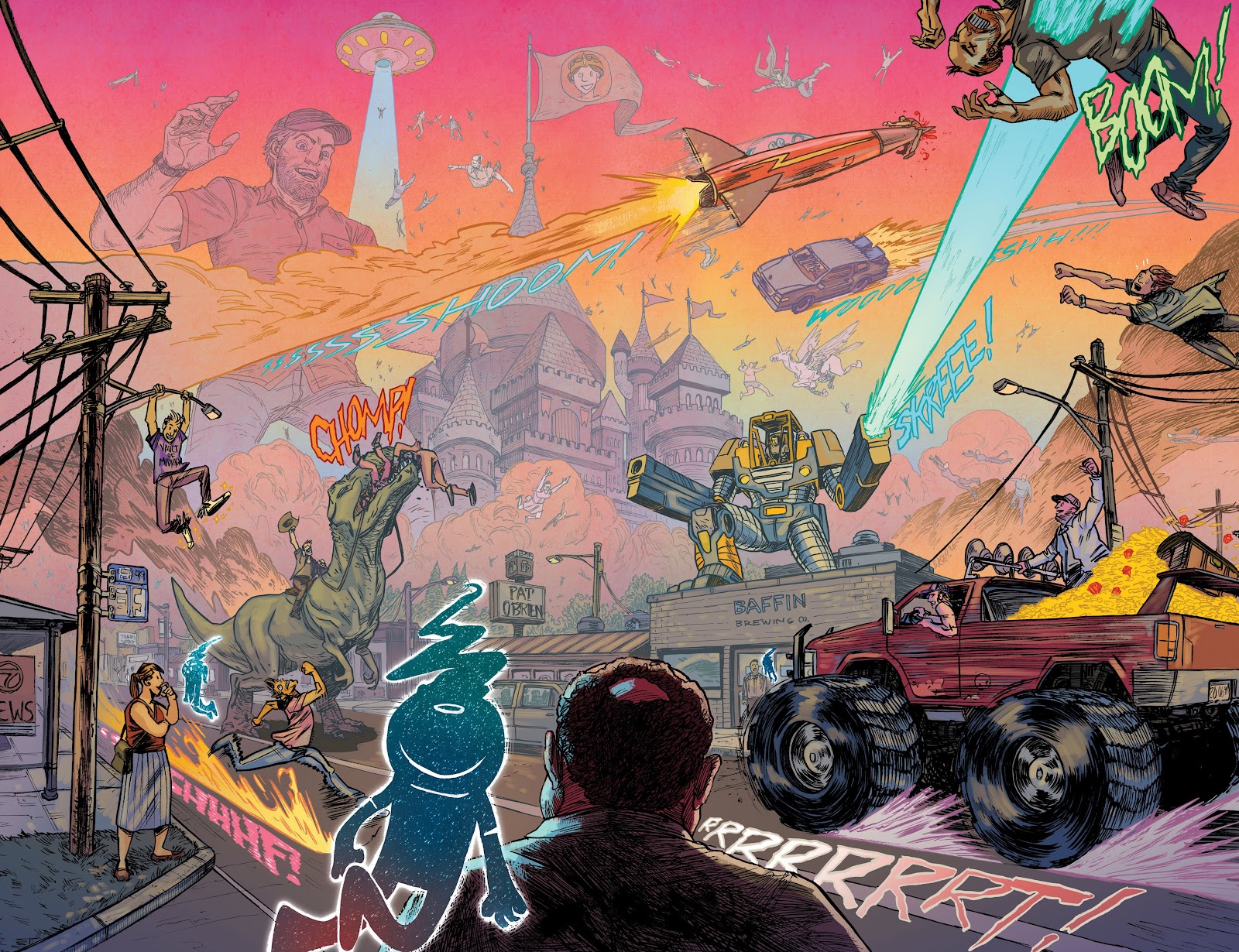
Comments